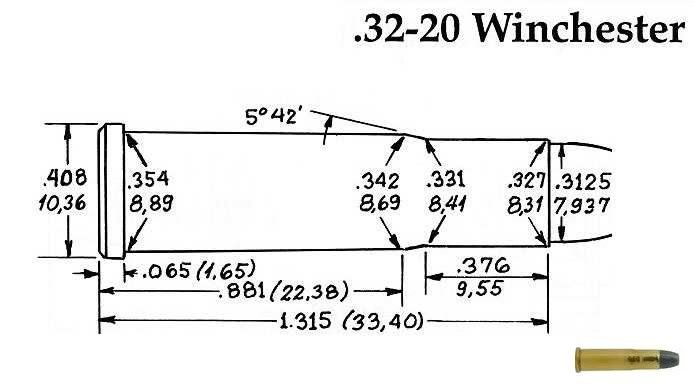Saturday, December 27, 2008
My Soon-to-Be AR-15
I recently purchased a Del-Ton stripped lower receiver and ordered a parts kit and upper. Apparently, an EBR was in my future and I'm fulfilling my duties as a member of the unorganized militia. I should have gotten it in January 2008 but didn't. So, now, I'll play the waiting game just like everyone else. One thing though. I've got primers and powder. Another thing is that my ideal didn't change over the intervening months. That kinda surprised me. Perhaps there was more reason in my thought process than I thought.
Sunday, December 21, 2008
Concealed Carry Map
From Handgun Law is this map showing the "shall issue," "may issue" and "don't issue" states with a few comments besides.
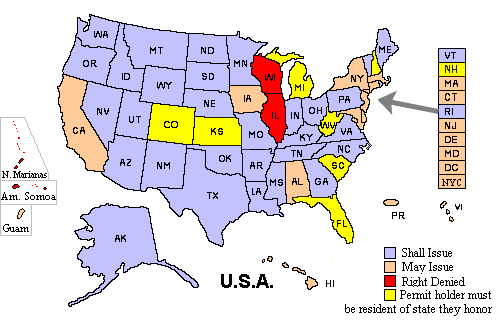

Saturday, December 20, 2008
Stock Making from Scratch by Marlinman93(Vall)
On Paco Kelly's Leverguns Forum, Marlinman93 (Vall) has posted his method of creating a pattern for creation of a stock on a stock duplicator. Re-published here with his permission, the series will be combined in this one article.
This will be long and drawn out, as it takes time between steps waiting for things to dry. I'm in the process of building a set of stocks for my double gun project, and thought I'd take some pictures to describe how I do it. Not sure how others do it, but this has been my method. I start by building the stocks from the inside out. This way I can fit pieces next to the action and barrel, rather than carving out a stock and then cutting in the inletting.
I start by covering the entire area with good quality plastic wrap. Tape it in a couple places to keep it in place:
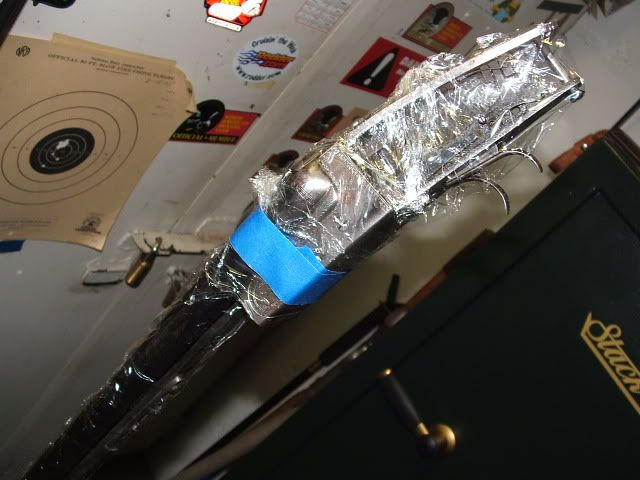
Next I get some soft fir or other wood that is easily cut and shaped. I fit the wood in pieces around the metal, and glue the pieces together with Gorilla glue. Don't worry about a perfect fit, as that will be the last step before sanding:
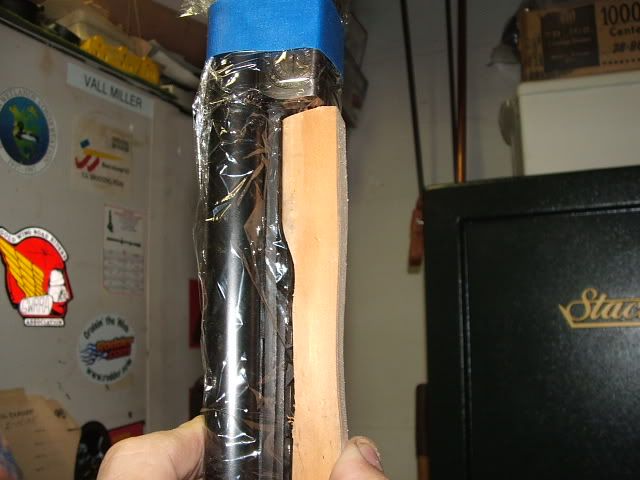
The forearm will be done in 4 pieces. Three for the bottom, and one for the tip:

The buttstock will end up being a lot of small pieces and one large piece:
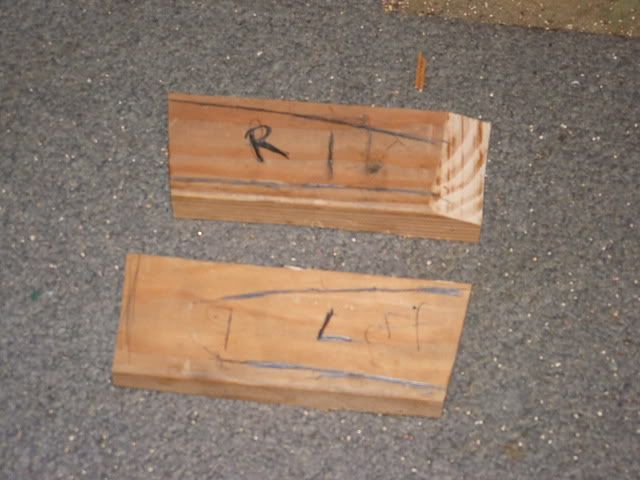
Tape and rubber bands work well to hold it all together while the glue sets up:

On this project Im using a donor stock (old Marlin 27) so I wont have to carve all the shape. I want a cheekpiece, so I cut one out on the band saw and glued it on. The screws will be removed when the glue sets up:
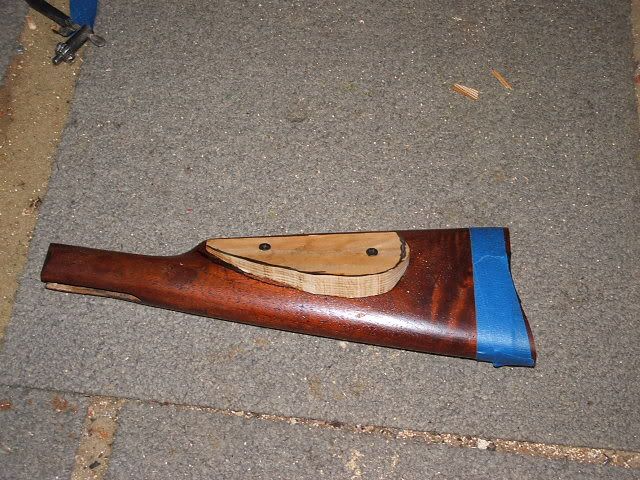
When all this dries I'll attach the stock to the pieces already fitted, fill in some more pieces, and then final fit the wood to the action using plain old body filler. I'll also mold in the cheekpiece and buttstock using the same. When it's done I'll have a perfect pattern to send to the duplicator.
I fitted pieces of wood to the action and forearm and have them close. I installed the cheekpiece and donor stock to the inletted fir pieces.
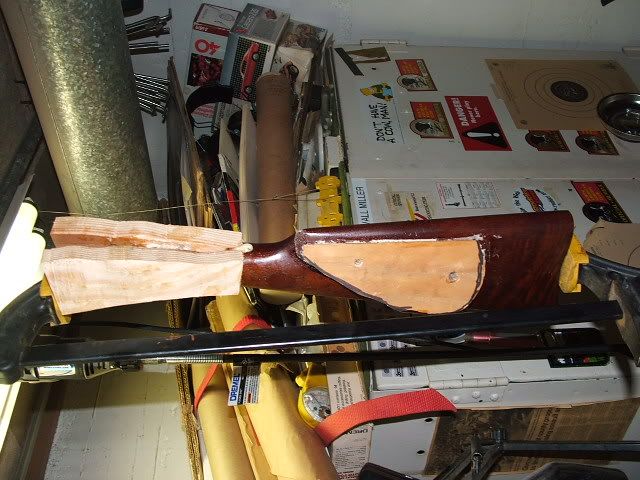
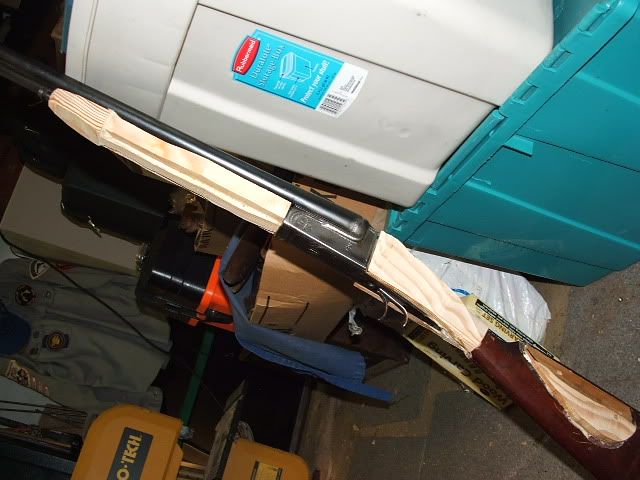
Next I bondo the wood to the action and bondo the cheekpiece into the stock.
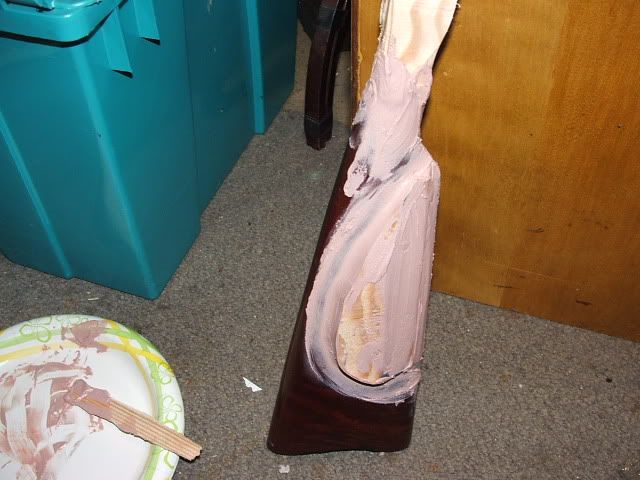
After drying I rough shape the bondo with a coarse rasp, and later I'll do final filling and sand to a close finish.
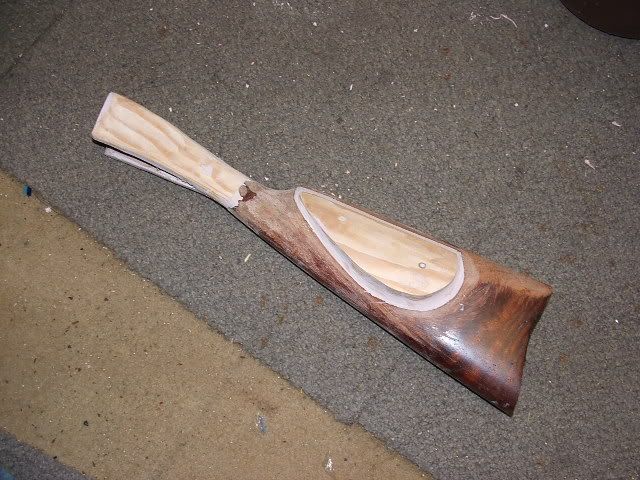
It doesn't need to be perfect for a pattern, but the closer the better, as that saves woodwork later!
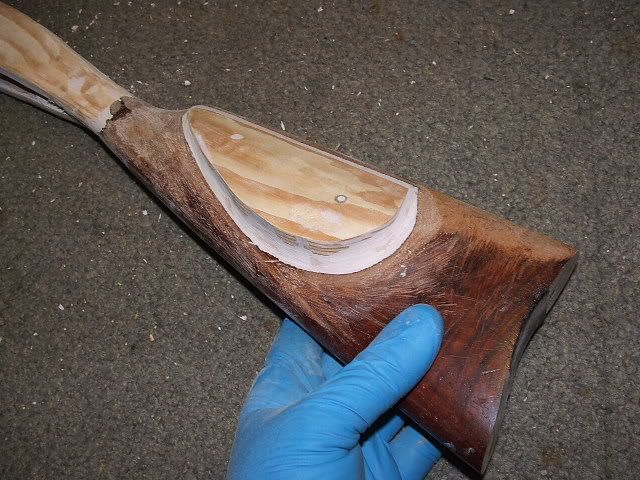
The forearm is next to get a few more pieces of wood, and then final shaping with bondo and a rough rasping. Here it's fitted to the receiver, and will be shaped the rest of the way when the fit is perfect.
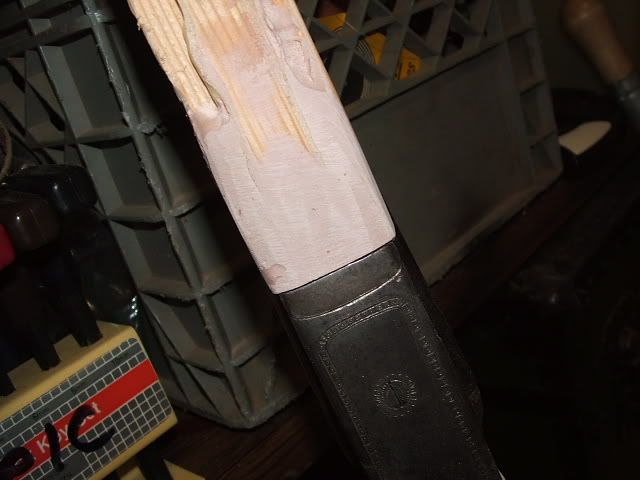
This will be long and drawn out, as it takes time between steps waiting for things to dry. I'm in the process of building a set of stocks for my double gun project, and thought I'd take some pictures to describe how I do it. Not sure how others do it, but this has been my method. I start by building the stocks from the inside out. This way I can fit pieces next to the action and barrel, rather than carving out a stock and then cutting in the inletting.
I start by covering the entire area with good quality plastic wrap. Tape it in a couple places to keep it in place:

Next I get some soft fir or other wood that is easily cut and shaped. I fit the wood in pieces around the metal, and glue the pieces together with Gorilla glue. Don't worry about a perfect fit, as that will be the last step before sanding:

The forearm will be done in 4 pieces. Three for the bottom, and one for the tip:

The buttstock will end up being a lot of small pieces and one large piece:

Tape and rubber bands work well to hold it all together while the glue sets up:

On this project Im using a donor stock (old Marlin 27) so I wont have to carve all the shape. I want a cheekpiece, so I cut one out on the band saw and glued it on. The screws will be removed when the glue sets up:

When all this dries I'll attach the stock to the pieces already fitted, fill in some more pieces, and then final fit the wood to the action using plain old body filler. I'll also mold in the cheekpiece and buttstock using the same. When it's done I'll have a perfect pattern to send to the duplicator.
I fitted pieces of wood to the action and forearm and have them close. I installed the cheekpiece and donor stock to the inletted fir pieces.


Next I bondo the wood to the action and bondo the cheekpiece into the stock.

After drying I rough shape the bondo with a coarse rasp, and later I'll do final filling and sand to a close finish.

It doesn't need to be perfect for a pattern, but the closer the better, as that saves woodwork later!

The forearm is next to get a few more pieces of wood, and then final shaping with bondo and a rough rasping. Here it's fitted to the receiver, and will be shaped the rest of the way when the fit is perfect.

Friday, December 19, 2008
Slingshots
Slingshots can certainly be useful tools. David used one to slay Golaith. The Egyptians had whole units of slingers. Over the years the design has gotten more high-tech due to the introduction of elastic rubber as the propulsive force rather than the centrifugal force of slinging the projectile in a large arc before releasing it at the target. In consequence, some have given them other names such as bean shooter. A while back I think I posted on this weapon used by youth gangs in Timor.
Quite something, these utilize the modern elastic force and require, perhaps, a little less skill/practice for effective use. I bet these could be used for hunting. However, you'd want to find your dart. After all, you'd have considerable fabrication time or money tied up in each one.
One could use lead balls (shot) or nuts (such as go on bolts to become fasteners). We used nuts from our supply sources together with Wrist Rockets to kill ground squirrels on Fort Hunter-Liggett, CA. Effective (when contact was made) cheap, silent, concealable and untraceable.
Rocks as projectiles are a whole different story. They can be found in appropriate sizes most anywhere. Rocks cost nothing. They carry no ballistic information whatsoever (except for the trace they pick up on contact with the target). Think they aren't viable? Look at this video of Rufus Hussey and his bean shooter. That is impressive.
Quite something, these utilize the modern elastic force and require, perhaps, a little less skill/practice for effective use. I bet these could be used for hunting. However, you'd want to find your dart. After all, you'd have considerable fabrication time or money tied up in each one.
One could use lead balls (shot) or nuts (such as go on bolts to become fasteners). We used nuts from our supply sources together with Wrist Rockets to kill ground squirrels on Fort Hunter-Liggett, CA. Effective (when contact was made) cheap, silent, concealable and untraceable.
Rocks as projectiles are a whole different story. They can be found in appropriate sizes most anywhere. Rocks cost nothing. They carry no ballistic information whatsoever (except for the trace they pick up on contact with the target). Think they aren't viable? Look at this video of Rufus Hussey and his bean shooter. That is impressive.
Tuesday, December 16, 2008
Saturday, December 13, 2008
Life Experience
A silly thing but I thought it might turn out to have useful info for the grandchildren...
1. Started your own blog. Yes, this here journal intended for your edification.
2. Slept under the stars. Many nights, maybe too many, maybe not enough. Stars are nice even in the cold. Clouds can be ok. Wet is just nasty.
3. Played in a band. Music is not my thing...
4. Visited Hawaii. On a jet plane and only long enough to go on across the pond. Dittos for Alaska although we did get off the plane while it refueled.
5. Watched a meteor shower. Who would not run outside to watch a meteor shower?
6. Given more than you can afford to charity. Accidentally. I gave what I thought was reasonable only to discover it was more than I should have done.
7. Been to Disneyland. If Disney WORLD counts. If so I've been there 4 too many times.
8. Climbed a mountain. I take it this is a named mountain and not restricted to Mount Everest, Mont Blanc or some such...
9. Held a praying mantis. They are all over the place here in late summer.
10. Sang a solo. I was often ordered by the music teacher to lip-synch so that nobody would hear me. That's just how badly I sing. Beat out Milli-Vanilli by many years but was never chastised for it!
11. Bungee jumped. There is no reason on earth to trust your life to a minimum wage worker and a rubber-band.
12. Visited Paris. Well, I rode a bus through the outskirts.
13. Watched a lightning storm at sea. Does looking out over the ocean from land during a hurricane count?
14. Taught yourself an art from scratch. Art=singing=no, dittos for artistic drawing.
15. Adopted a child. She didn't want to be adopted but my step-daughter is my daughter...
16. Had food poisoning. Not really but I've had gastro-intestinal discomfort on an epic scale!
17. Walked to the top of the Statue of Liberty.
18. Grown your own vegetables. Yep, but that was in spite of my efforts.
19. Seen the Mona Lisa in France.
20. Slept on an overnight train.
21. Had a pillow fight. A looooooong time ago...
22. Hitch hiked. I was walking the 13 miles home (was between King City and Greenfield) from my broken down car and several migrant workers picked me up and dropped me at my exit. I still remember and am still grateful. Gracias.
23. Taken a sick day when you’re not ill. Yes, but I was sick of work.
24. Built a snow fort. Where I lived, EVERYBODY my age who was physically able to has built a snow fort.
25. Held a lamb. Yes.
26. Gone skinny dipping. At Pfeiffer Beach for one...
27. Run a Marathon.
28. Ridden in a gondola in Venice.
29. Seen a total eclipse.
30. Watched a sunrise or sunset. Many, most due to sleeping under the stars!
31. Hit a home run.
32. Been on a cruise. And I might get forced into doing it again but it won't be willingly going!
33. Seen Niagara Falls in person. 5 times now.
34. Visited the birthplace of your ancestors. Of course.
35. Seen an Amish community. Visited several times and always ate well.
36. Taught yourself a new language. I think that is impossible for me to teach myself but I have learned some Mandarin (WAS literate), Korean, French, and American Sign Language. It is difficult to teach oneself language, you need to learn to think it, a hard thing for me to do on my own.
37. Had enough money to be truly satisfied. I'm there right now. To be well fed, warm, dry and able to study the things that interest you, that is a good life.
38. Seen the Leaning Tower of Pisa in person.
39. Gone rock (wall) climbing. And rappelling (abseiling).
40. Seen Michelangelo's David.
41. Sung karaoke. Did you miss my comment on singing?
42. Seen Old Faithful geyser erupt. In a thunderstorm. A boy scout was struck by lightning. A magnificent juxtaposition of all of nature's power at one place and time. The scout lived.
43. Bought a stranger a meal at a restaurant.
44. Visited Africa.
45. Walked on a beach by moonlight. Asilomar in 1974, Ormond several times between 1989 and 2005.
46. Been transported in an ambulance.
47. Had your portrait painted/drawn. A characterture.
48. Gone deep sea fishing.
49. Seen the Sistine Chapel in person.
50. Been to the top of the Eiffel Tower in Paris.
51. Gone scuba diving or snorkeling.
52. Kissed in the rain. But not often enough. Women do not consider me a good kisser. Don't kiss men.
53. Played in the mud.
54. Gone to a drive-in theater. Among others I saw "The Exorcist" in a drive-in.
55. Been in a movie. "Lights of Inchon" as an extra but I'm probably on the cutting room floor.
56. Visited the Great Wall of China.
57. Started a business.
58. Taken a martial arts class.
59. Visited Russia.
60. Served at a soup kitchen.
61. Sold Girl Scout Cookies. However, I've done my bit by buying and eating a ton of the Thin Mints.
62. Gone whale watching.
63. Got flowers for no reason. Yes, I remember that...
64. Donated blood, platelets or plasma. Some crummy fever I had in Korea was reason not to accept my blood.
65. Gone sky diving. And I won't as long as every plane I fly in is still flying.
66. Visited a Nazi Concentration Camp.
67. Bounced a check. Only because the BANK didn't credit my deposit within 5 days.
68. Flown in a helicopter. Many, many times. Jumped from the skid and rappelled from one, too.
69. Saved a favorite childhood toy. Crafield, the stuffed bear. Well, really, my mom saved him.
70. Visited the Lincoln Memorial.
71. Eaten Caviar.
72. Pieced a quilt.
73. Stood in Times Square. I have now (2011). Not that great a thing.
74. Toured the Everglades.
75. Been fired from a job.
76. Seen the Changing of the Guards in London.
77. Broken a bone. Broke my wrist on an obstacle course.
78. Been on a speeding motorcycle. Drove a speeding motorcycle.
79. Seen the Grand Canyon in person. AND floated on the Colorado River, twice.
80. Published a book. I've been quoted in a book.
81. Visited the Vatican.
82. Bought a brand new car. Several times.
83. Walked in Jerusalem.
84. Had your picture in the newspaper. Servicing a HMMVW just prior to a big snow storm and teaching school kids about the Army.
85. Read the entire Bible. Hasn't every Christian? Seriously, it was a project.
86. Visited the White House. Took the tour.
87. Killed and prepared an animal for eating. Several.
88. Had chickenpox.
89. Saved someone’s life. And been saved.
90. Sat on a jury. Not yet although I return the questionnaire in a timely manner.
91. Met someone famous. Penn and Teller, John O. Marsh (Secretary of the Army), Edgar and Mrs. Bergen, several of the Statler Brothers, several authors and artists...
92. Joined a book club. I suppose everybody can be that stupid.
93. Lost a loved one. Way too many. I doubt that as I age the rate of loss will decline, unless of course I go first.
94. Had a baby. Well, not me personally, but I do have children.
95. Seen the Alamo in person. A lifetime highlight.
96. Swam in the Great Salt Lake. I've SEEN The Great Salt Lake. My understanding is that few want to swim in it anymore.
97. Been involved in a law suit. Testified.
98. Owned a cell phone. Only this past year and only because I HAD to.
99. Been stung by a bee. I'm sure I'll be stung a few more times, too, although I am getting better at avoiding it.
100. Read an entire book in one day. I've read more than one in one day.
1. Started your own blog. Yes, this here journal intended for your edification.
2. Slept under the stars. Many nights, maybe too many, maybe not enough. Stars are nice even in the cold. Clouds can be ok. Wet is just nasty.
3. Played in a band. Music is not my thing...
4. Visited Hawaii. On a jet plane and only long enough to go on across the pond. Dittos for Alaska although we did get off the plane while it refueled.
5. Watched a meteor shower. Who would not run outside to watch a meteor shower?
6. Given more than you can afford to charity. Accidentally. I gave what I thought was reasonable only to discover it was more than I should have done.
7. Been to Disneyland. If Disney WORLD counts. If so I've been there 4 too many times.
8. Climbed a mountain. I take it this is a named mountain and not restricted to Mount Everest, Mont Blanc or some such...
9. Held a praying mantis. They are all over the place here in late summer.
10. Sang a solo. I was often ordered by the music teacher to lip-synch so that nobody would hear me. That's just how badly I sing. Beat out Milli-Vanilli by many years but was never chastised for it!
11. Bungee jumped. There is no reason on earth to trust your life to a minimum wage worker and a rubber-band.
12. Visited Paris. Well, I rode a bus through the outskirts.
13. Watched a lightning storm at sea. Does looking out over the ocean from land during a hurricane count?
14. Taught yourself an art from scratch. Art=singing=no, dittos for artistic drawing.
15. Adopted a child. She didn't want to be adopted but my step-daughter is my daughter...
16. Had food poisoning. Not really but I've had gastro-intestinal discomfort on an epic scale!
17. Walked to the top of the Statue of Liberty.
18. Grown your own vegetables. Yep, but that was in spite of my efforts.
19. Seen the Mona Lisa in France.
20. Slept on an overnight train.
21. Had a pillow fight. A looooooong time ago...
22. Hitch hiked. I was walking the 13 miles home (was between King City and Greenfield) from my broken down car and several migrant workers picked me up and dropped me at my exit. I still remember and am still grateful. Gracias.
23. Taken a sick day when you’re not ill. Yes, but I was sick of work.
24. Built a snow fort. Where I lived, EVERYBODY my age who was physically able to has built a snow fort.
25. Held a lamb. Yes.
26. Gone skinny dipping. At Pfeiffer Beach for one...
27. Run a Marathon.
28. Ridden in a gondola in Venice.
29. Seen a total eclipse.
30. Watched a sunrise or sunset. Many, most due to sleeping under the stars!
31. Hit a home run.
32. Been on a cruise. And I might get forced into doing it again but it won't be willingly going!
33. Seen Niagara Falls in person. 5 times now.
34. Visited the birthplace of your ancestors. Of course.
35. Seen an Amish community. Visited several times and always ate well.
36. Taught yourself a new language. I think that is impossible for me to teach myself but I have learned some Mandarin (WAS literate), Korean, French, and American Sign Language. It is difficult to teach oneself language, you need to learn to think it, a hard thing for me to do on my own.
37. Had enough money to be truly satisfied. I'm there right now. To be well fed, warm, dry and able to study the things that interest you, that is a good life.
38. Seen the Leaning Tower of Pisa in person.
39. Gone rock (wall) climbing. And rappelling (abseiling).
40. Seen Michelangelo's David.
41. Sung karaoke. Did you miss my comment on singing?
42. Seen Old Faithful geyser erupt. In a thunderstorm. A boy scout was struck by lightning. A magnificent juxtaposition of all of nature's power at one place and time. The scout lived.
43. Bought a stranger a meal at a restaurant.
44. Visited Africa.
45. Walked on a beach by moonlight. Asilomar in 1974, Ormond several times between 1989 and 2005.
46. Been transported in an ambulance.
47. Had your portrait painted/drawn. A characterture.
48. Gone deep sea fishing.
49. Seen the Sistine Chapel in person.
50. Been to the top of the Eiffel Tower in Paris.
51. Gone scuba diving or snorkeling.
52. Kissed in the rain. But not often enough. Women do not consider me a good kisser. Don't kiss men.
53. Played in the mud.
54. Gone to a drive-in theater. Among others I saw "The Exorcist" in a drive-in.
55. Been in a movie. "Lights of Inchon" as an extra but I'm probably on the cutting room floor.
56. Visited the Great Wall of China.
57. Started a business.
58. Taken a martial arts class.
59. Visited Russia.
60. Served at a soup kitchen.
61. Sold Girl Scout Cookies. However, I've done my bit by buying and eating a ton of the Thin Mints.
62. Gone whale watching.
63. Got flowers for no reason. Yes, I remember that...
64. Donated blood, platelets or plasma. Some crummy fever I had in Korea was reason not to accept my blood.
65. Gone sky diving. And I won't as long as every plane I fly in is still flying.
66. Visited a Nazi Concentration Camp.
67. Bounced a check. Only because the BANK didn't credit my deposit within 5 days.
68. Flown in a helicopter. Many, many times. Jumped from the skid and rappelled from one, too.
69. Saved a favorite childhood toy. Crafield, the stuffed bear. Well, really, my mom saved him.
70. Visited the Lincoln Memorial.
71. Eaten Caviar.
72. Pieced a quilt.
73. Stood in Times Square. I have now (2011). Not that great a thing.
74. Toured the Everglades.
75. Been fired from a job.
76. Seen the Changing of the Guards in London.
77. Broken a bone. Broke my wrist on an obstacle course.
78. Been on a speeding motorcycle. Drove a speeding motorcycle.
79. Seen the Grand Canyon in person. AND floated on the Colorado River, twice.
80. Published a book. I've been quoted in a book.
81. Visited the Vatican.
82. Bought a brand new car. Several times.
83. Walked in Jerusalem.
84. Had your picture in the newspaper. Servicing a HMMVW just prior to a big snow storm and teaching school kids about the Army.
85. Read the entire Bible. Hasn't every Christian? Seriously, it was a project.
86. Visited the White House. Took the tour.
87. Killed and prepared an animal for eating. Several.
88. Had chickenpox.
89. Saved someone’s life. And been saved.
90. Sat on a jury. Not yet although I return the questionnaire in a timely manner.
91. Met someone famous. Penn and Teller, John O. Marsh (Secretary of the Army), Edgar and Mrs. Bergen, several of the Statler Brothers, several authors and artists...
92. Joined a book club. I suppose everybody can be that stupid.
93. Lost a loved one. Way too many. I doubt that as I age the rate of loss will decline, unless of course I go first.
94. Had a baby. Well, not me personally, but I do have children.
95. Seen the Alamo in person. A lifetime highlight.
96. Swam in the Great Salt Lake. I've SEEN The Great Salt Lake. My understanding is that few want to swim in it anymore.
97. Been involved in a law suit. Testified.
98. Owned a cell phone. Only this past year and only because I HAD to.
99. Been stung by a bee. I'm sure I'll be stung a few more times, too, although I am getting better at avoiding it.
100. Read an entire book in one day. I've read more than one in one day.
Friday, December 12, 2008
Is an EBR in my future?
Acquaintance has an "extra" Del-Ton stripped lower receiver (yes, AR-15 type) for sale. Asked if I'd be interested. Maybe. Looked at the options for the rest of it at Del-Ton.
16" M4 Rifle Kit
- DTI 16" M4 1x7 Chrome Lined
- CAR Handguard with Heat Shields-Black
- Standard Bolt & Carrier
- M4 Buttstock - Black
- A2 Grip - Black
- No Carrying Handle
- A2 Flash Hider
- Single Rail Gas Block
- Standard Lower Parts
- Standard Charging Handle
- Flat Top Upper with T-Marks
AR-15 Multi Tool
AR-15 Lower Receiver Vice Block
Flip Up Front Sight for Gas Block
Flip Up Rear Sight
What I want is a carbine that will shoot the heavy bullets and take a scope without having to look at the front sight in the sight picture. Still want "irons" just in case. I might just put a Weaver 2½X on it and get another scope for whatever I steal the Weaver from. I get the impression from looking at all the various "makes" that this stuff is very much commodity as opposed to any real differences depending on brand. Frankly, after years of dealing with the M16A1 and A2 in the position of armorer (or pseudo-armorer/supply sergeant/only person left at the point of contact) I'm not exactly wound up about the high-tech modern plug and play gadgetry that is out there. I do believe I have a sling, cleaning kit, BFA and muzzle cover on hand.
16" M4 Rifle Kit
- DTI 16" M4 1x7 Chrome Lined
- CAR Handguard with Heat Shields-Black
- Standard Bolt & Carrier
- M4 Buttstock - Black
- A2 Grip - Black
- No Carrying Handle
- A2 Flash Hider
- Single Rail Gas Block
- Standard Lower Parts
- Standard Charging Handle
- Flat Top Upper with T-Marks
AR-15 Multi Tool
AR-15 Lower Receiver Vice Block
Flip Up Front Sight for Gas Block
Flip Up Rear Sight
What I want is a carbine that will shoot the heavy bullets and take a scope without having to look at the front sight in the sight picture. Still want "irons" just in case. I might just put a Weaver 2½X on it and get another scope for whatever I steal the Weaver from. I get the impression from looking at all the various "makes" that this stuff is very much commodity as opposed to any real differences depending on brand. Frankly, after years of dealing with the M16A1 and A2 in the position of armorer (or pseudo-armorer/supply sergeant/only person left at the point of contact) I'm not exactly wound up about the high-tech modern plug and play gadgetry that is out there. I do believe I have a sling, cleaning kit, BFA and muzzle cover on hand.
Thursday, December 11, 2008
Cartridge Adapters
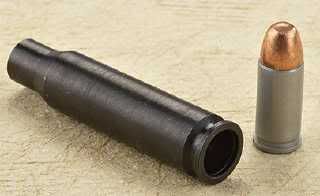
I recently bought two cartridge adapters from Sportsman's Guide. I got one each in .308 Winchester and .303 British. These allow the use of .32 ACP cartridges in rifles chambered for the adapter cartridge. This would be very handy in allowing the taking of small game without the need to fire a full-power load and the adapter is readily distinguishable from a standard cartridge. I can't wait to get my guns out there and try this. However others have reported good success with these and other, similar adapters from other sources.
Basically a steel cartridge for a .30 or .31 caliber center-fire rifle such as the .308 Winchester, .30-06 Springfield or .303 British (in the "case" of the Sportsman's Guide product) which is itself chambered for the .32 ACP cartridge. One of these is shown in the accompanying photo. These have been around for a long time and versions have been made to chamber a variety of suitable smaller catridges in larger chambered rifles with appropriate bores.
Saturday, December 06, 2008
Concealed Carry will be Permitted on Department of Interior Lands
The rule change has been announced and will likely be published next week. 30 days after publication the rule change goes into effect and you and I will be able to carry concealed in accordance with the laws of the state in which we are at the time. Of course we still won't be able to poach (but poachers are CRIMINALS and by definition are breaking the law) but we didn't do that anyway. All we wanted was to defend ourselves FROM poachers and other CRIMINALS...
H-S Precision and the Lon Horiuchi Endorsement
11/26/08
It has been suggested that this may be a malicious photoshop joke. I hope so. I read one comment that compared Lon Horiuchi's endorsement of sniper rifles to Timothy McVeigh's endorsement of fertilizer. Tasteless at best. Click on the pic to get it full size.
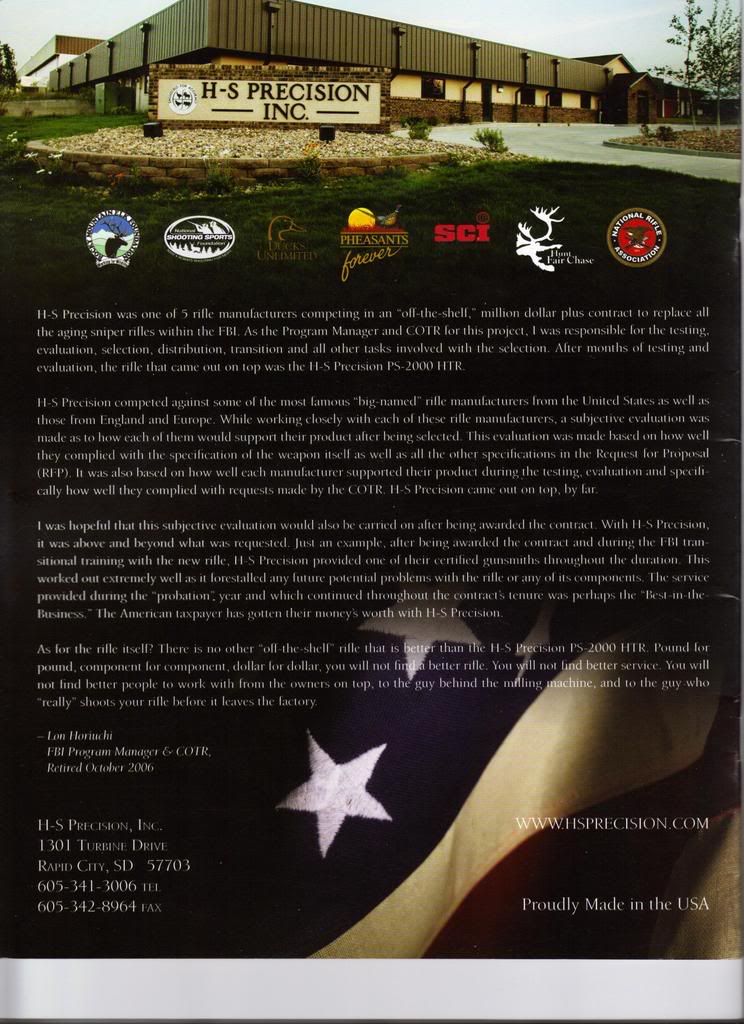
If you want to complain, contact info is:
H-S PRECISION, INC.
1301 TURBINE DRIVE,
RAPID CITY, SD 57703
(605) 341-3006 TEL
(605) 342-8964 FAX
info@hsprecision.com
* * * * *
12/02/08
In keeping with my attempts to consolidate posts/entries updates will be provided in this post and the post republished on the update date.
Courtesy of The War on Guns
* * * * *
And the saga continues....
It seems to me that HS got the message, in part. They now know that they offended a number of their potential customers. It is unfortunate but I doubt they can honestly do much more than this. They knew who Horiuchi is and they went with his endorsement. It is now for you to decide if you will or won't patronize them. Certainly you can patronize Remington. With both Zumbo and HS they've stood for our rights.
It has been suggested that this may be a malicious photoshop joke. I hope so. I read one comment that compared Lon Horiuchi's endorsement of sniper rifles to Timothy McVeigh's endorsement of fertilizer. Tasteless at best. Click on the pic to get it full size.

If you want to complain, contact info is:
H-S PRECISION, INC.
1301 TURBINE DRIVE,
RAPID CITY, SD 57703
(605) 341-3006 TEL
(605) 342-8964 FAX
info@hsprecision.com
12/02/08
In keeping with my attempts to consolidate posts/entries updates will be provided in this post and the post republished on the update date.
Courtesy of The War on Guns
update from Tommy Millner at Remington:
Because its thanksgiving and everyone is off, we have not made contact with HS. We have taken any reference to HS from our web site..
When you first emailed me I honestly did not recall horiuchi's name so you caught me unawares. I also do not read the blogs so the fact there was an issue came as a surpise.
In any event, HS makes a great product and we are a large customer of theirs. Why they would pick a super controversial spokesperson is beyond me. Doing this violates pure business common sense. Early next week we will use whatever persuasive powers at our disposal to get HS to do the right thing..
Do me a favor and tell those on the bolgs that Remington and I are now fully aware of the issue, in full agreement with the outrage, and will do what we can t exert pressure on HS to reverse course.
And the saga continues....
To Our Valued Customers:
H-S Precision has received comments relating to individual testimonials in our 2008 catalog. All of the testimonials focused on the quality, accuracy and customer service provided by H-S Precision.
The management of H-S Precision did not intend to offend anyone or create any type of controversy. We are revising our 2009 catalog and removing all product testimonials.
Sincerely,
The Management of H-S Precision
It seems to me that HS got the message, in part. They now know that they offended a number of their potential customers. It is unfortunate but I doubt they can honestly do much more than this. They knew who Horiuchi is and they went with his endorsement. It is now for you to decide if you will or won't patronize them. Certainly you can patronize Remington. With both Zumbo and HS they've stood for our rights.
Wednesday, December 03, 2008
Dating Remingtons...
The following letters correspond to the month (first letter) and year of manufacture starting in 1921 and ending in 1972 (next one or two letters):
Using barrel codes (such as those listed above) to date the manufacture are reliable on Remington rifles, as the company rarely changed barrels on a customer's rifle.
Using these barrel codes to date a shotgun is somewhat unreliable, as shotgun barrels are often interchanged at random. One needs to be sure that the barrel is original to the gun before trusting the Barrel Code listing, above.
| B-Jan | M-1921 | C-1934 | SS-1947 | G-1960 |
| L-Feb | N-1922 | D-1935 | TT-1948 | H-1961 |
| A-Mar | P-1923 | E-1936 | UU-1949 | J-1962 |
| C-Apr | R-1924 | F-1937 | WW-1950 | K-1963 |
| K-May | S-1925 | G-1938 | XX-1951 | L-1964 |
| P-Jun | T-1926 | H-1939 | YY-1952 | M-1965 |
| O-Jul | U-1927 | J-1940 | ZZ-1953 | N-1966 |
| W-Aug | W-1928 | K-1941 | A-1954 | P-1967 |
| D-Sep | X-1929 | L-1942 | B-1955 | R-1968 |
| E-Oct | Y-1930 | MM-1943 | C-1956 | S-1969 |
| R-Nov | Z-1931 | NN-1944 | D-1957 | T-1970 |
| X-Dec | A-1932 | PP-1945 | E-1958 | U-1971 |
| B-1933 | RR-1946 | F-1959 | W-1972 |
Using barrel codes (such as those listed above) to date the manufacture are reliable on Remington rifles, as the company rarely changed barrels on a customer's rifle.
Using these barrel codes to date a shotgun is somewhat unreliable, as shotgun barrels are often interchanged at random. One needs to be sure that the barrel is original to the gun before trusting the Barrel Code listing, above.
Monday, December 01, 2008
I am officially a Jinx.
My first day at the gun shop and the ATF does an unannounced inspection. Might be a bit of a misnomer as they say all are unannounced. The boss had locked himself out of his house, had a trace on a gun, and this. I helped for a bit but he closed for the inventory and there was nothing to do. A good 2-1/2 hours spent not doing much of anything but answering the phone and doing some grunt work like bending and reaching for guns.
It all started with a good shower and a shave. Then I reported for my first day. We were just getting started when a lady walks in, "Hi, I'd like to see ______" (the owner). "I'm _______ ATF agent here to do an inspection. Be here all week. We'll start with an inventory, then we'll compare to your book and go from there."
I helped with the inventory (mostly reaching and such). Then left.
The two agents did apologize for having to do this during such a busy time of year (hunting, post-election, pre-Christmas). First time for the owner. The agents seemed nice enough, but mostly business.
We had a murder here in town yesterday afternoon. 20 year old woman killed by her 27 year old boyfriend (convicted sex offender) with a .25 ACP "PIC" pistol. The murder was a large part of the conversation for a bit. The owner was an officer on the Staunton PD for 13 years before buying the place from Ernie.
Well, anyway there was no need for me to be there with no sales paying my way. So, I went home and counted the change in my change jar and wrapped it up to take to the bank. $376.
It all started with a good shower and a shave. Then I reported for my first day. We were just getting started when a lady walks in, "Hi, I'd like to see ______" (the owner). "I'm _______ ATF agent here to do an inspection. Be here all week. We'll start with an inventory, then we'll compare to your book and go from there."
I helped with the inventory (mostly reaching and such). Then left.
The two agents did apologize for having to do this during such a busy time of year (hunting, post-election, pre-Christmas). First time for the owner. The agents seemed nice enough, but mostly business.
We had a murder here in town yesterday afternoon. 20 year old woman killed by her 27 year old boyfriend (convicted sex offender) with a .25 ACP "PIC" pistol. The murder was a large part of the conversation for a bit. The owner was an officer on the Staunton PD for 13 years before buying the place from Ernie.
Well, anyway there was no need for me to be there with no sales paying my way. So, I went home and counted the change in my change jar and wrapped it up to take to the bank. $376.
Saturday, November 29, 2008
Tenite Stocked Savage-Stevens M94
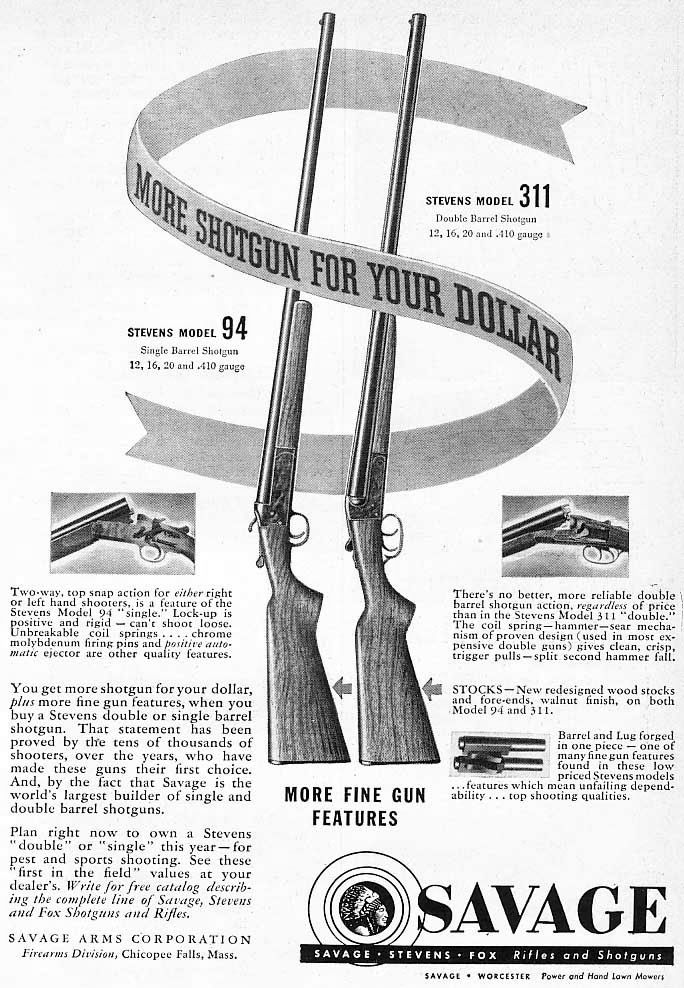 The Savage 94 single-shot shotgun recently came to my attention by way of helping a recently widowed friend. This shotgun is interesting for a number of reasons. It is one of the better single-shots, a light and handy gun and the stock isn't walnut or other hardwood but Tenite.
The Savage 94 single-shot shotgun recently came to my attention by way of helping a recently widowed friend. This shotgun is interesting for a number of reasons. It is one of the better single-shots, a light and handy gun and the stock isn't walnut or other hardwood but Tenite.Tenite, an Eastman Corporation synthetic (cellulose acetate butyrate) from 1929 was much used in the 1930s for automotive parts. It weighs considerably less than wood and is quite stable. In keeping with Eastman's tradition of environmental consciousness, Tenite is made from 100% renewable softwood materials. It is GREEN! According to the fine Larry Sterrett article (“Tenite and the early synthetics in the Long Gun Industry”, 1997 “GUN DIGEST”), Tenite was announced as a stock choice in 1939, put in use in 1940, shelved for WWII, reintroduced in late ’45 or ‘46 and officially used until 1950. Apparently some old inventory of stocks got used up, and this continued until 1954.
Tenite can be molded to precise shapes, and therefore offered some advantages for gunstocks. It is not a particularly cheap product but had a track record in use as a material for US bayonet scabbards produced by Beckwith Manufacturing spinoff Victory Plastics as well as football helmets.
The rest of the gun is pretty unremarkable. It has seen quite a bit of use as evidenced by the well worn finish. However, it has been well cared for, there isn't much rust at all on it.
The 20 gauge is an appropriate choice for a gun this light. Most people will find the recoil of even very many 20 gauge rounds to be punishing and even one round of 12 gauge to be downright objectionable from a 5-1/2 lb gun.
We sold this gun for our widow friend. I'll get a chance to catch a couple of photos of it before it goes down the road because that friend wants me to clean it up for him. This will require at least partial disassembly.
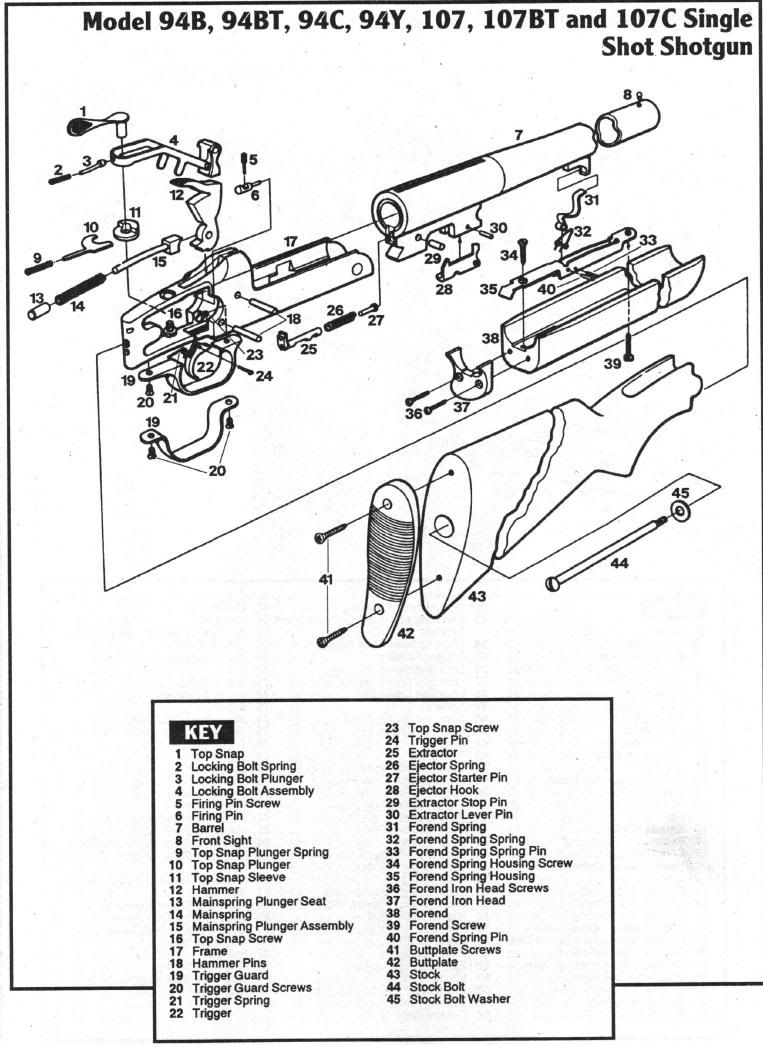 The 94B (which this is) isn't a particularly complicated mechanism. It has been around a long time because it works and it is durable. It was also inexpensive to manufacture and to buy and was a mainstay in farms all across the country. I'm sure Montgomery Wards and Sears & Roebuck sold many thousands.
The 94B (which this is) isn't a particularly complicated mechanism. It has been around a long time because it works and it is durable. It was also inexpensive to manufacture and to buy and was a mainstay in farms all across the country. I'm sure Montgomery Wards and Sears & Roebuck sold many thousands.
Tuesday, November 25, 2008
New (additional) Job
At 9 AM on Monday, December 1, 2008 I begin work at:

Y'all stick your head in and say hi to Hobie. This may slow my blogging and moderating down a bit. Have patience.

Y'all stick your head in and say hi to Hobie. This may slow my blogging and moderating down a bit. Have patience.
Wednesday, November 19, 2008
Crosman 130 (Now the 1300) .177 cal Air Pistol
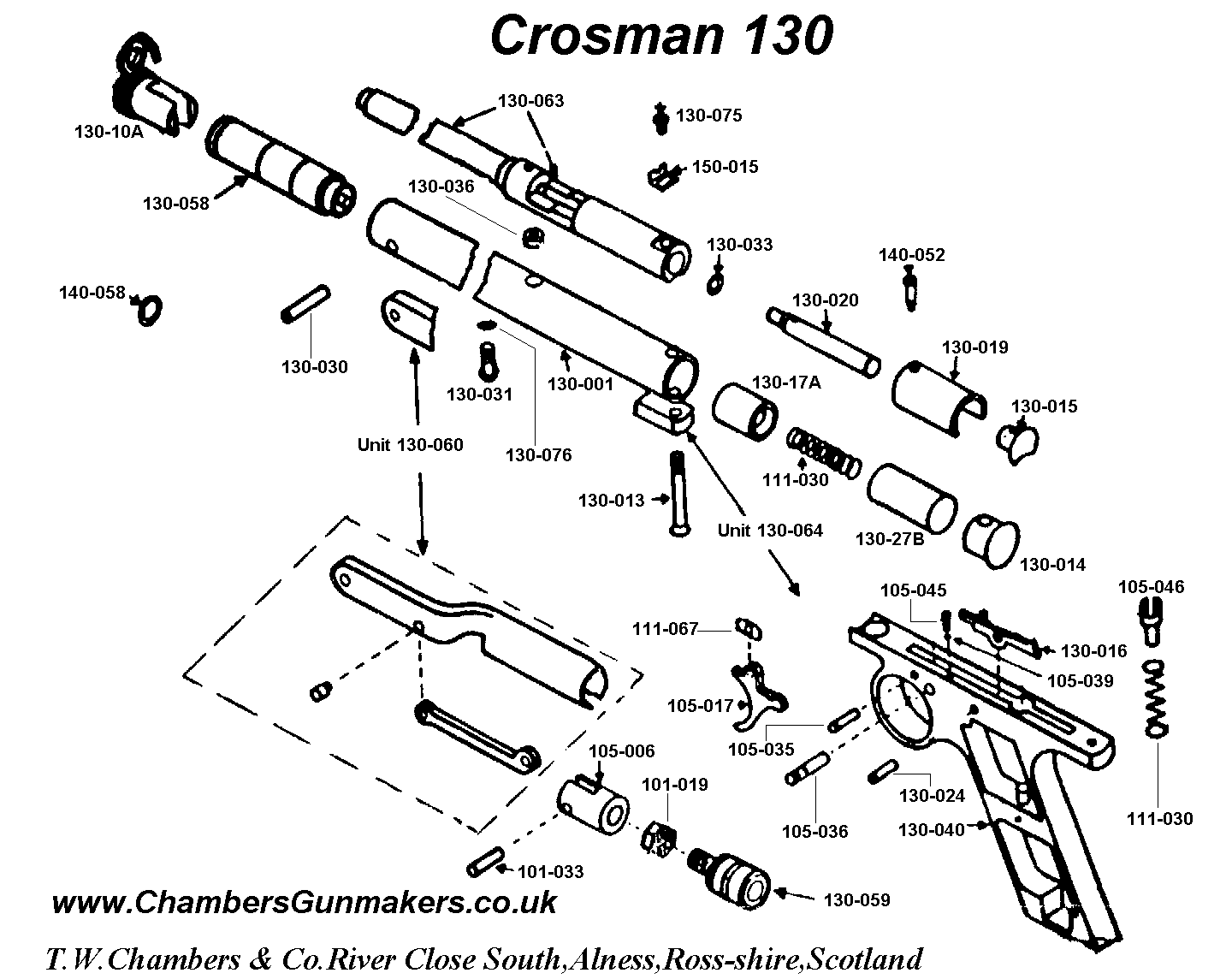 Over 40 years ago I had a fascination with handguns but neither the money nor the age necessary to indulge my youthful fantasies. I don't remember quite how, but I finally prevailed on my parents to allow me to purchase a Crosman 130 in .22 caliber. Suffering from years of inexperience I was convinced the .22 would hit harder. I'm not completely certain now, but I think I got mine at a department store called Town and Country in the Cloverleaf Mall in Harrisonburg, VA. At least I had the great good fortune, maybe even intelligence, to pick one of the most successful air pistols of all time. I know this one gave good service.
Over 40 years ago I had a fascination with handguns but neither the money nor the age necessary to indulge my youthful fantasies. I don't remember quite how, but I finally prevailed on my parents to allow me to purchase a Crosman 130 in .22 caliber. Suffering from years of inexperience I was convinced the .22 would hit harder. I'm not completely certain now, but I think I got mine at a department store called Town and Country in the Cloverleaf Mall in Harrisonburg, VA. At least I had the great good fortune, maybe even intelligence, to pick one of the most successful air pistols of all time. I know this one gave good service. 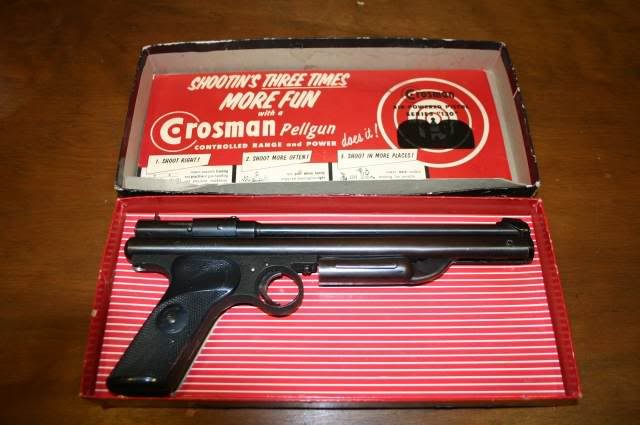 The Crosman 130 pneumatic was made from 1953 to 1970. It was a multi-pump pneumatic in .22 caliber (there was also a .177 caliber). These guns replaced the model 105/106 multi-pump pistols that had been in the Crosman line since 1947. Where the 105/106 guns were conventional in all ways, the 130/137 were considered innovative. When they over-pumped them, the valves would lock up and the guns would either fire very weakly or not at all. To prevent over-pumping, Crosman engineers invented a new type of valve that worked much differently. Instead of knocking the valve open with a heavy hammer, the new valve used the trigger to hold the valve shut until the trigger was pulled and released the air. The only bad thing was that the trigger pull gets heavier and rougher as the air pressure increases. Maybe this is why I'm so insensitive to trigger pull variations.
The Crosman 130 pneumatic was made from 1953 to 1970. It was a multi-pump pneumatic in .22 caliber (there was also a .177 caliber). These guns replaced the model 105/106 multi-pump pistols that had been in the Crosman line since 1947. Where the 105/106 guns were conventional in all ways, the 130/137 were considered innovative. When they over-pumped them, the valves would lock up and the guns would either fire very weakly or not at all. To prevent over-pumping, Crosman engineers invented a new type of valve that worked much differently. Instead of knocking the valve open with a heavy hammer, the new valve used the trigger to hold the valve shut until the trigger was pulled and released the air. The only bad thing was that the trigger pull gets heavier and rougher as the air pressure increases. Maybe this is why I'm so insensitive to trigger pull variations.I now know that isn't necessarily true that bigger is better, at least in the airgun world. My replacement air pistol was a Webley Tempest. It is a .177 caliber gun and has served me well. Still, that .22 gave me a lot of confidence at the time. After some 10,000 pellets fired downstairs into my cardboard box trap, I knew I could hit what I wanted to hit when I wanted to.
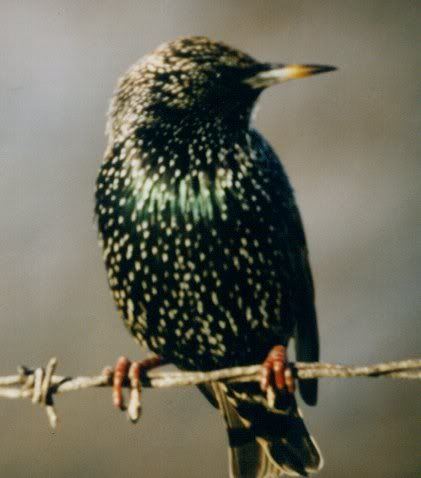 You see, my biggest quarry was the hated European Starling. Yes, my dad detested these birds. Consequently, he didn't mind my shooting them right off his bird feeders where they were competing with Grosbeaks, Mourning Doves, Cardinals, and other song birds for seed.
You see, my biggest quarry was the hated European Starling. Yes, my dad detested these birds. Consequently, he didn't mind my shooting them right off his bird feeders where they were competing with Grosbeaks, Mourning Doves, Cardinals, and other song birds for seed. My bedroom window was a tape measured 55 feet from the bird feeder. Right next to the bird feeder was a Sweet Gum tree. The birds would go back and forth from the tree to the feeder or the sunflower seed on the ground feeder. I would attempt to wack all the starlings possible. It is interesting, but the other bird species soon figured out that they were not the target of my tender ministrations. Flying pellets soon came to be of no concern to them and I never betrayed that trust. There were one or two problems though.
The first problem was that the starling has a natural breast shield of feathers. Well, it is a shield to the flat nosed pellet. That was the second problem.
In those halcyon days, the widely unfettered use of .22 Shorts or .22LR shot cartridges in many areas had precluded a need for a quieter substitute. Pellets were readily available in one flavor only and that was with the big flat nose. Excellent for use on paper targets and cutting sharp, easy-to-score holes in same but not so good as a penetrator on "game". After a few solid "wacks" on starling breasts only to see maybe one downy feather fall to earth (and twice to find the undamaged pellet on the ground!) without a dead bird, I knew I had to do something. But what?
At first I thought that all I needed was more velocity. I pumped up that poor gun until my arms ached but if I got more velocity it did no good and likely it damaged/wore the pistols seals more. My next thoughts were that I needed a sharper bullet point and that I needed more bullet weight. I looked around for usable source.
The first source was .22 Short ammo. I pulled the bullets, dumped the powder charge in the garden and, when nobody else was home, shot the now empty cases in my dad's 72 (I should have simply reseated the bullets! We didn't know about CB caps at the time.) I tried the bullets both with the heel (a 29 gr. bullet) but they seemed too heavy for the gun and velocity was pitiful but when I cut the heel off using my pocket knife I got a usable projectile and got a couple of starlings with those. Unfortunately Dad "cut off" my source of .22 Shorts. What to do now?
I had read somewhere about casting lead cores for swaging bullets. Obviously I didn't have much money and not nearly enough to design and swage my own pellets but I did have some lead and solder. So, I made lead "wire" by casting lead in a channel in sand in the yard. I then rolled lengths of this "wire" between two steel plates to make it "round" and cut it to pieces about the same length as my abbreviated .22 Short bullets. I then filed the bases flat and made the noses pointy with "well-aimed" taps from a small tack hammer. These VERY crude projectiles weren't all that accurate compared to the factory made flat-point pellets but they sure did penetrate.
Along the way, I noticed that accuracy was difficult with a handgun (surprise!) and tried an approach that I'd seen used with the Broomhandle Mauser. I.e. I took a balsa wood "board" purchased at a hobby shop and carved a butt stock that cradled the gun at the butt and lower rear of the receiver. This worked fairly well improving my hit rate but the butt wasn't attached to the gun and one had to put it together for every shot.
Sadly, my experiments and depredations on the wiley starling came to an end as my 130 finally died. Improperly maintenance, over pumping, use of too heavy projectiles and wear from firing (likely more than 20,000 times) was too much.
Now some 36 years later, Crosman has changed the design but the 1377C has inherited the mantle of the 130 and sells for $55 and up. There was a time when it was offered with a one-piece grip/buttstock (which you can still buy separately) but that has gone by the wayside with Crosman's acquisition of the Benjamin and Sheridan lines. It was simply redundant!
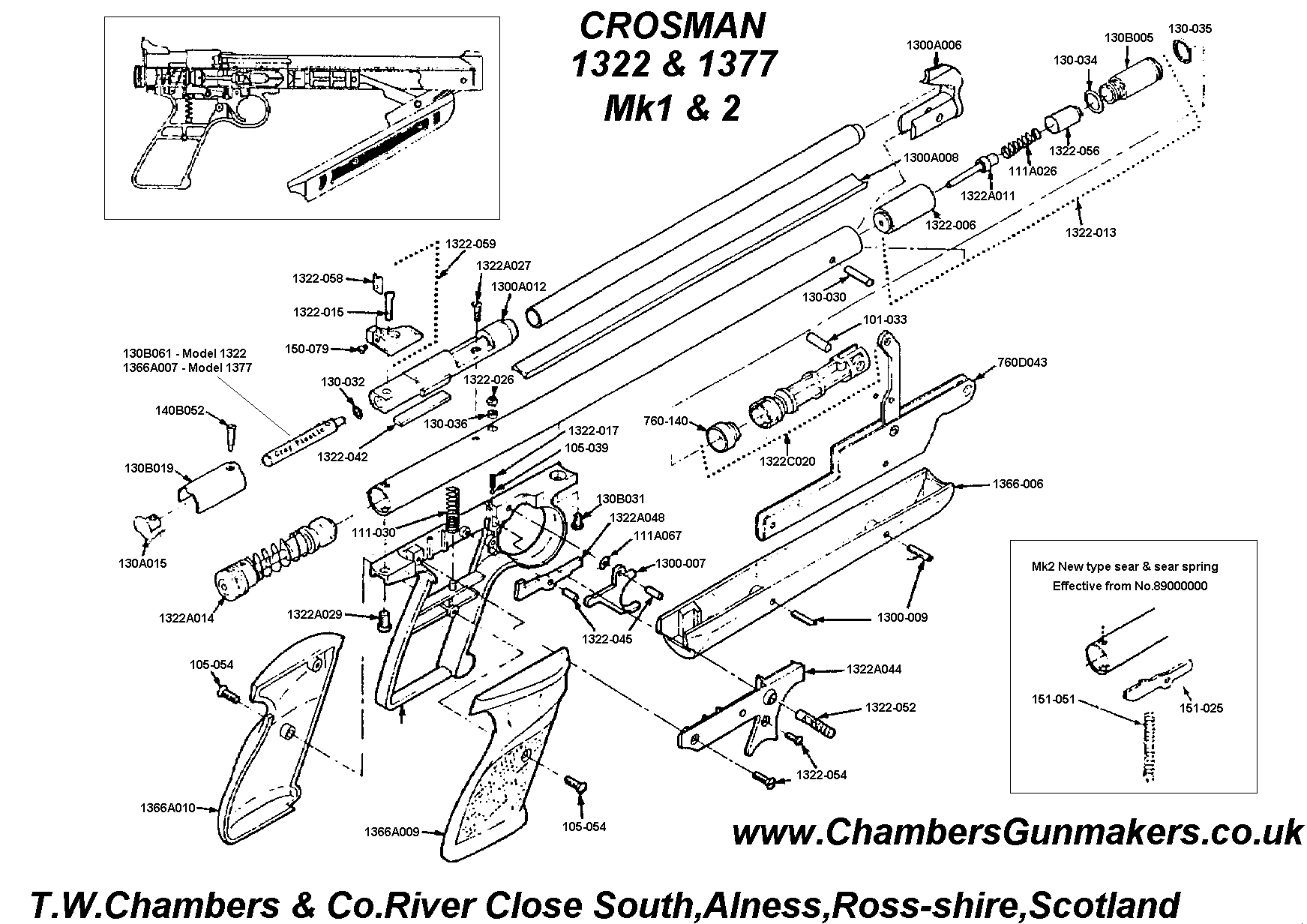
Tuesday, November 18, 2008
Lipsey's to Distribute Ruger Blackhawk Flattop .44 Special
I'm excited, like a lot of Ruger fans, .44 Special fans and Flattop fans, as Lipsey's will be distributing these Ruger Blackhawk Flattop .44 Specials. John Taffin would call this the perfect packin' pistol (PPP) and I think he's probably right. Now, if they would only do one in .45 Colt.
First snow of the season!
We awoke to our first snow of the season. Only a "skiff" under the trees but might help with tracking. I do have some pre-thanksgiving stuff to do but I'm excited.
November 15-29
In the counties (including the cities and towns within) of Augusta, Bland, Craig, Giles, Pulaski, Rockingham, Scott, and Wythe.Either-sex Deer Hunting Days:
- November 22-29: In all areas unless otherwise noted below.
- November 22 and November 29: On National Forest and Department-owned lands in Augusta, and on National Forest lands in Bland, Craig, Giles, Pulaski, Rockingham and Wythe, and on the Big Survey WMA, and on private lands west of Routes 613 and 731 in Rockingham County.
- Antlered deer only-no either-sex deer hunting days: On National Forest lands in Scott. Special Youth Antlerless Deer Regulation applies.
Sunday, November 09, 2008
Squirrel Hunting
 Squirrel hunting is fun. You can go just about anyplace you can shoot and see squirrels. You can hunt squirrels with all sorts of guns although you might have to be a bit adaptable. You can eat squirrels. You can even shoot several squirrels every day (here it is 6 per day). Lots of fun.
Squirrel hunting is fun. You can go just about anyplace you can shoot and see squirrels. You can hunt squirrels with all sorts of guns although you might have to be a bit adaptable. You can eat squirrels. You can even shoot several squirrels every day (here it is 6 per day). Lots of fun. For those who don't know, there are two common types of squirrels in this part of Virginia, the fox (first photo) and the gray. There is also the tiny red but we don't have those here, at least not in noticeable quantities. When I was a kid we did all our squirrel hunting with shotguns. I'm not exactly certain as to why but that's what we did. I for one didn't like finding a #6 shot in my dinner. Maybe I'm just picky. Anyway, I switched to a .22 LR gun. At first, I had only my dad's M72 Winchester. Fitted with the factory peep sight, this gun was good enough for squirrels out to 50 yards or so. Honestly, headshots had to be at 10-25 yards. I didn't trust myself not to overshoot at 10 yards so I'd shoot them in the chest. It isn't all that hard to get close to a squirrel. I think the biggest reason I switched was to avoid the lead additives in my food! You do have to watch your backstop, or lack of backstop, with the rifle(s).
 In the old days, the .32 and .36 muzzleloaders were the ticket for small game. These work really well on squirrels when loading a round ball over 15-25 gr. of blackpowder or suitable substitute such as Pyrodex. In fact, my favorite squirrel rifle is my .36 caliber Thompson-Center Seneca. Gifted to me on my 18th Christmas, this is gun didn't even get shot until 8 years of service in the US Army passed. I then fell in love with the gun when used on squirrels and rabbits. Why are they so effective? Well the mild charge of powder and light weight of the ball combine to minimize recoil which contributes to pleasant shooting. Also, the ball is of the correct size to be effective (it as big as any expanded .22 LR bullet will ever be on such light game) and still accurate at these relatively short ranges of not more than 50 yards or so.
In the old days, the .32 and .36 muzzleloaders were the ticket for small game. These work really well on squirrels when loading a round ball over 15-25 gr. of blackpowder or suitable substitute such as Pyrodex. In fact, my favorite squirrel rifle is my .36 caliber Thompson-Center Seneca. Gifted to me on my 18th Christmas, this is gun didn't even get shot until 8 years of service in the US Army passed. I then fell in love with the gun when used on squirrels and rabbits. Why are they so effective? Well the mild charge of powder and light weight of the ball combine to minimize recoil which contributes to pleasant shooting. Also, the ball is of the correct size to be effective (it as big as any expanded .22 LR bullet will ever be on such light game) and still accurate at these relatively short ranges of not more than 50 yards or so.To squirrel hunt I take my tool of choice for the day and go to a place where I both have permission and there is food for squirrels. They are everywhere there's food for them and after a relaxing sit-down at least one will make his presence known. Many times, especially if you pay attention to where you sit, you won't even have to get up to take your limit. I have done so even while wandering around with chatting kids in tow.
After you take a squirrel, you need to move him from the forest to the dinner plate. The first step in that process is skinning the little buggers. That can be a chore and it was for me at times. Fortunately, Mr. Squack produced a video of a neat method to quickly and cleanly remove the overburden from some squirrel gravy (although I'm not a gravy guy, I stir fry mine!).
After washing and deboning the meat, your next step is to discover a favorite recipe. All the better if your partner/spouse already knows one. Bon appetite!
Wednesday, November 05, 2008
Long Term Storage of Firearms
Please read this stuff, for quite obvious reasons!
Long term storage of guns - relatively short, MUST READ. Mentions Brownell's Triple Tough Bags and Rust Blox combination for great long term protection of firearms in storage.
Where to get long term gun storage bags and tablets
If the above link doesn't work simply log on to Brownells and look in their cleaning supplies tab, then enter "Triple Tough" in the search box.
Storage bags and tabs for 12 long guns, 12 handguns currently comes to just a tad over $100.00 from Brownell's, at least if you are a registered customer.
Prices will suddenly go up and/or supplies will dwindle very soon
John de Fresno
Links:
Burying Guns? by Massad Ayoob
Bury a gun and ammo
for 15 years
(and be assured everything still works when you dig it up) by Charles Wood
Long term storage of guns - relatively short, MUST READ. Mentions Brownell's Triple Tough Bags and Rust Blox combination for great long term protection of firearms in storage.
Where to get long term gun storage bags and tablets
If the above link doesn't work simply log on to Brownells and look in their cleaning supplies tab, then enter "Triple Tough" in the search box.
Storage bags and tabs for 12 long guns, 12 handguns currently comes to just a tad over $100.00 from Brownell's, at least if you are a registered customer.
Prices will suddenly go up and/or supplies will dwindle very soon
John de Fresno
Links:
Burying Guns? by Massad Ayoob
Bury a gun and ammo
for 15 years
(and be assured everything still works when you dig it up) by Charles Wood
Sunday, November 02, 2008
Build Your Own AR
Brownell offers a FREE video series on building an AR. They also have it in PDF form. Hat tip to Xavier for this tip. I'd seen it but didn't remember to post it.
Now, why you would do this? Simply look at the news.
Now, why you would do this? Simply look at the news.
Saturday, November 01, 2008
Military Musketry
I happened on this Youtube video of drill for "Last of the Mohicans". I thought it was interesting.
Uberti Remington New Model Army 5½-inch
The Remington New Model Army revolver was manufactured by E. Remington & Sons of Ilion, New York, from 1863 to 1875. An average of 10,000 per year were manufactured (most during the Civil War, 1863-1865) for an approximate total of 132,000 revolvers. This six-shot, .44 caliber revolver was the second most issued to Union soldiers pistol during the Civil War. The New Model was proceeded by the Old Model Army, of which 12,000 were produced circa 1862. The Old Model had a dovetailed front sight, and the loading lever was cut so the cylinder could be removed without lowering the lever. The Army found both features unacceptable and the New Model Army features a loading lever that must be dropped for cylinder removal and a screw-in post front sight. One of the oddities of these revolvers is that the Old Model Army has a patent date of Dec 17, 1861 and the New Model Army, it's replacement, has a patent date of Sept 14, 1858! It is interesting to note that the reproductions most often use the dovetailed front sight of the Old Model Army but the New Model Army loading lever.
 Once upon a time in a place that now seems so far away called San Angelo, Texas, I bought a revolver. Along for that ride, maybe an instigator now that I think about it, was my dear friend Perry Fuller. Perry had taken me to a gun shop in downtown San Angelo as a break from the tiring classes at Goodfellow Air Force Base. I suppose he didn't intend for me to buy a cap'n'ball revolver but I did. This Lyman marketed, Italian copy of the Remington New Model Army was my first handgun of over .177" caliber. With a can of DuPont 3F, some Remington caps, a can of Crisco lard and a popsicle stick I was all ready to go shooting.
Once upon a time in a place that now seems so far away called San Angelo, Texas, I bought a revolver. Along for that ride, maybe an instigator now that I think about it, was my dear friend Perry Fuller. Perry had taken me to a gun shop in downtown San Angelo as a break from the tiring classes at Goodfellow Air Force Base. I suppose he didn't intend for me to buy a cap'n'ball revolver but I did. This Lyman marketed, Italian copy of the Remington New Model Army was my first handgun of over .177" caliber. With a can of DuPont 3F, some Remington caps, a can of Crisco lard and a popsicle stick I was all ready to go shooting. The two of us went out in the vicinity of Lake Nasworthy and proceeded to shoot up some cactii and an armadillo. Not exactly responsible, but we were certain to watch our backstop! I believe we also got a quail or two out there (which Perry's wife Amy graciously prepared for dinner!) using Perry's 20 ga. Ithaca M66 lever-action shotgun. In any case, that was great fun and when I got home on leave I was eager to show Dad just how it worked. He liked it but had one concern. The grip size.
Now my hands are about average in size but Dad's were pretty large. He was 6' 1" and his hands were a little larger than one might think would be proportional. That early NMA grip disappeared in those paws! Even in my average sized mitts, the grips felt a bit on the small side. The guns were supposed to be accurate reproductions of Civil War era revolvers used by men so why were the grips small?
Well, it seems that when the Italian gun makers first started to reproduce the guns, they were casting the frames and somehow while the copied the dimensions for the frames from originals there was a bit of shrinkage in the castings and the guns came out a bit on the small side in some dimensions. Fast forward to about 2000 and correctly dimensioned guns were beginning to come on the market. Now, Uberti produces a forged, steel frame version, some with color-cased frames. Barrel lengths are not just in the 8" original length but also in 5-1/2", a more desirable length to modern CAS shooters.
Taylor's & Co., Inc. of Winchester, Virginia distributes these guns but I'm sure you can get them from other firms like Dixie Gun Works. The Uberti guns come in typical Uberti boxes. There's the usual manual but also NRA and other literature included. No nipple wrench is included and you will need one.
Loading these guns is actually pretty straight forward. It is a good primer (pun intended) for the budding reloader. First, the gun must be cleaned to ensure there is no grease or oil in the chambers or nipples. Excess oil should be removed and I strongly suggest that no petroleum based oils or greases be used on the gun as exposure to blackpowder (or substitutes) and heat can create a "tar" that can be terribly difficult to remove. This fouling on the cylinder can tie up the gun in short order and is well avoided. Also lay out your components/ensure you have everything you need before you start. There is nothing so irritating as having to go find a component in the middle of the process. Don't ask me how I know. You will need:
- .454" pure lead round balls or the correct conical bullets
- #11 percussion caps
- greased over-powder wads and/or grease/lard for application over the bullet. This is important to both lubricate the bullet and to prevent accidentally igniting the powder charge from the front.
- 2F or 3F BP or substitute
- powder measure or flask with measure
I prefer to fire two caps on each chamber to ensure that all nipple flash holes are clean through and through and dry. The fired caps are removed from the nipples and we move on to actual loading.
I charge and seat the ball/ball&wad one chamber at a time and then move on to the next chamber. It is preferred to load only five chambers and leave one empty. The gun is carried with the hammer resting on the nipple of this empty chamber. To do this the gun is placed on half-cock so that the cylinder can rotate freely. It is held muzzle up in my left hand so that can do the other tasks with my right. A charge is measured and poured and the wad, then ball is seated using the loading lever. Only after I've completed loading each chamber do I go back and apply the grease over the ball with the popsicle stick, tongue depressor or other suitably shaped applicator. Excess grease is wiped off. The gun, still held in my left hand is then capped and the cylinder rotated and the hammer let down on the nipple of the empty chamber. The gun is now ready for carry and/or firing.
Typical powder charges are 25-35 gr. (limited by the size of the chamber) and round-balls weigh about 144 gr. Velocities are typically in the 700-850 fps range and produce energy levels about on par with .38 Special round nose lead ammunition. However, the larger diameter pure lead ball gives better terminal performance. Find the load your revolver likes best and you can likely shoot cloverleafs to some very interesting distances and you'll have a fine small to medium game revolver. Conical bullets often give better penetration on target but less accuracy. Molds are available from Lee, Lyman and others.
After shooting, timely cleaning is strongly recommended. It isn't necessary to completely disassemble the revolver after every shooting session. My Lyman hasn't had that done in 25 years but a peek inside shows no BP buildup. It is necessary to clean the cylinder (removing the nipples for a thorough cleaning), bore and exterior of the revolver. Hot, soapy water is my preferred solvent. Hot water helps heat the metal so that it dries more quickly. After cleaning give it a protective wipe down with Bore Butter or other non-petroleum based oil.
Thursday, October 30, 2008
Ithaca M37 Riot Shotgun
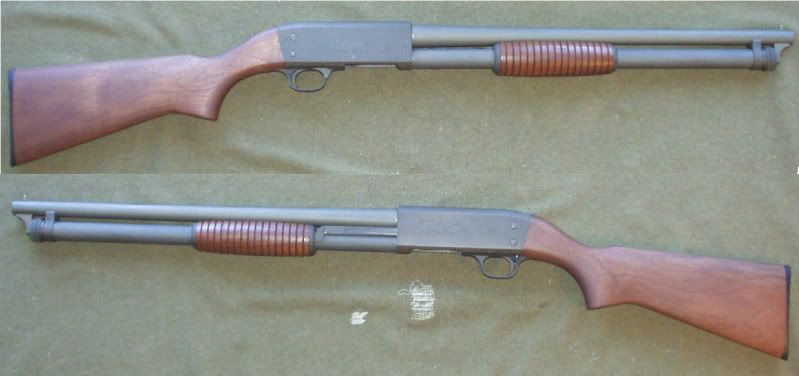 |
| Ithaca Model 37 Riot - right and left side views |
"It" is a 1964 manufactured Ithaca M37 Featherlight, parkerized 12 gauge riot gun with 2-3/4" chamber, 20" barrel and full-length/7-round magazine. UNFIRED, formerly mint and NIB (I've ruined that by simply removing the barrel), this gun has a left-hand safety. That will be changed. It is unfortunate, but I've already discovered that putting my finger on the trigger it automatically pushes the current safety to the ON position, blocking the trigger and making this combat shotgun unshootable. Fortunately, the Ithaca M37 safety is easy to reverse requiring only a bit of screwdriver work (properly fitting screwdrivers, please), time and a right hand safety button. I think this is likely the reason this gun remained in unfired condition.
The Ithaca 37 Featherlight is a legend in the world of pump-action shotguns. The gun was designed by the famous firearms designers John Browning and John Pedersen and first sold as the Remington Model 17. The Model 17 was a 20-gauge of trim proportions which was later redesigned and refined into the popular Remington Model 31 which was replaced by the Remington 870 which is still made.
 After World War One, the Ithaca Gun Company was searching for a pump-action shotgun to produce and compete with the Winchester Model 12. Ithaca waited for Remington Model 17 patents to expire in order to produce that gun. After preparing for production of the Ithaca model 33, they found more Pedersen patents that would not expire until 1937 so, along with the introduction date, they changed the model designation from 33 to 37.
After World War One, the Ithaca Gun Company was searching for a pump-action shotgun to produce and compete with the Winchester Model 12. Ithaca waited for Remington Model 17 patents to expire in order to produce that gun. After preparing for production of the Ithaca model 33, they found more Pedersen patents that would not expire until 1937 so, along with the introduction date, they changed the model designation from 33 to 37.The Great Depression and approaching world war wasn't the best time to introduce a sporting shotgun. That the M37 soldiered through the war proves it is a sound design. Production of many sporting guns ceased during this same period.
Ithaca resumed production of the Model 37 after WW-II. The Ithaca 37 has the longest production run for a pump-action shotgun in history and made in many models. The Ithaca 37 has been called the Model 87, but the M37 name was soon restored. In 2005 production halted when Ithaca once again changed hands but has resumed in Ohio.
This configuration is pretty much limited to use as a self-defense or police firearm. The 7-shot magazine makes it illegal for hunting in most states and most game. Being mostly out of production now, or at least at low production levels compared to some other shotguns, there aren't a lot of accessories out there. I kinda like that. While I have a fully accessorized, modular Winchester 120 (their successor to the M37's competitor the Winchester M12) I like the almost retro simplicity of this shotgun.
Disassembly
Before attempting disassembly, unload the magazine and chamber. To empty the magazine, push in the spring shell stop (13) on the inside of the receiver. Ease the shells out one by one. Pull back on the slide release on the forward side of the trigger guard, and pull back the slide handle to empty the chamber.
To re- move the barrel (1), pull back on the slide release and pull the slide handle assembly (12) to the rear to open the breech. Pull up the magazine nut pin (2) and use it as a lever to rotate the magazine nut (3) until the projection on it is free of the barrel lug. The magazine nut pin was furnished only on guns built prior to 1955. On later-built guns having no pin, simply rotate the magazine nut (Fig. 1).
The barrel is joined to the receiver by an interrupted thread. When the magazine nut is free of the barrel lug, give the barrel a one-quarter turn in the direction shown (Fig. 2) and pull it free of the receiver. The magazine tube and slide handle assembly will remain attached to the receiver.
The stock (53) must be removed before disassembling the action. First remove the buttplate screws and buttplate. The stock is attached to the receiver by a stock bolt (26) that has a square head with a slot so that it can be removed with a long screwdriver or socket wrench (Fig. 3).
With the stock removed, turn out the trigger plate screw (17) (Fig. 4) and slide the trigger plate group to the rear (Fig. 5) and out of the receiver. Remove the carrier screw lock screws (56) and carrier screws (55) from the receiver. Hold the receiver bottom up with the magazine to the left, and with a punch pull the slide pin (33) toward the body (Fig. 6) until the slide bar can be pulled forward from engagement with the slide (35). Pull the slide, breechblock (52) and carrier (42) together rearward out of the receiver.
The top extractor (47) is retained by a powerful spring. To remove it, use a thin punch to push the spring plunger back; at the same time push the extractor out of its seat (Fig. 7). The bottom extractor (43) can be removed easily by driving out its hinge pin (48). To remove the firing pin from the breechblock, first drive out the check pin (49). Then the firing pin and spring (51 and 50) can be removed easily rearward.
Reassembly is in the reverse order.
After about 20 min. including time figuring out WHICH pin punch to use for what AND moving the vise from one bench to the other, I've got a right-hand safety on the Ithaca M-37. Just in time, maybe, well, you know what I mean...
Gunpartscorp.com got the part to me in 4 days start to stop including a Sunday. A record. Correct part and fast...
I had a left-hand Ithaca M-37 safety with large button which I offered for sale here and on a couple of forums. As I believe I noted above, I HAD to switch because putting my finger on the trigger often pushed the safety button to the safe position. Not good in the middle of "use". I had a lot of interest (I was a bit surprised) but folks didn't want to pay as much as Numrich Gun Parts was charging for a used right-hand safety. I sold it for $20 shipped. $25 was too much for anyone but they wouldn't even give a counter-offer. In as much as it seems critical for certainty of use to have the correct safety and the left hand safety seems to be much rarer than the right, AND there are a lot of people out there looking for the left-hand safeties, this might not have been a good move on their part.
Links:
- Ithacagun Featherlight
- Manual - a PDF from Steve's Pages
Saturday, October 25, 2008
St Crispian's Day
If we are mark'd to die, we are enow
To do our country loss; and if to live,
The fewer men, the greater share of honour.
God's will! I pray thee, wish not one man more.
By Jove, I am not covetous for gold,
Nor care I who doth feed upon my cost;
It yearns me not if men my garments wear;
Such outward things dwell not in my desires.
But if it be a sin to covet honour,
I am the most offending soul alive.
No, faith, my coz, wish not a man from England.
God's peace! I would not lose so great an honour
As one man more methinks would share from me
For the best hope I have. O, do not wish one more!
Rather proclaim it, Westmoreland, through my host,
That he which hath no stomach to this fight,
Let him depart; his passport shall be made,
And crowns for convoy put into his purse;
We would not die in that man's company
That fears his fellowship to die with us.
This day is call'd the feast of Crispian.
He that outlives this day, and comes safe home,
Will stand a tip-toe when this day is nam'd,
And rouse him at the name of Crispian.
He that shall live this day, and see old age,
Will yearly on the vigil feast his neighbours,
And say 'To-morrow is Saint Crispian.'
Then will he strip his sleeve and show his scars,
And say 'These wounds I had on Crispian's day.'
Old men forget; yet all shall be forgot,
But he'll remember, with advantages,
What feats he did that day. Then shall our names,
Familiar in his mouth as household words-
Harry the King, Bedford and Exeter,
Warwick and Talbot, Salisbury and Gloucester-
Be in their flowing cups freshly rememb'red.
This story shall the good man teach his son;
And Crispin Crispian shall ne'er go by,
From this day to the ending of the world,
But we in it shall be remembered-
We few, we happy few, we band of brothers;
For he to-day that sheds his blood with me
Shall be my brother; be he ne'er so vile,
This day shall gentle his condition;
And gentlemen in England now-a-bed
Shall think themselves accurs'd they were not here,
And hold their manhoods cheap whiles any speaks
That fought with us upon Saint Crispin's day.
There are lessons aplenty here.
John A. Kopec Now On-Line
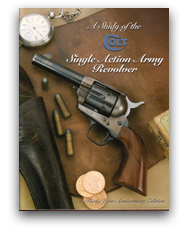 Mr. Kopec is an authority on Colt Single Action revolvers and he now has a site. On this site is contact information for both his authentication services and his publications. I have a copy of the latest edition of A Study of the Colt Single Action Army Revolver and I can't imagine any person interested in the subject being without one. It is a marvelous book, not only in content but in presentation and production quality as well.
Mr. Kopec is an authority on Colt Single Action revolvers and he now has a site. On this site is contact information for both his authentication services and his publications. I have a copy of the latest edition of A Study of the Colt Single Action Army Revolver and I can't imagine any person interested in the subject being without one. It is a marvelous book, not only in content but in presentation and production quality as well. Tyler T Grip Adapters
The Tyler T grip adapter was designed by Melvin Tyler back in 1952 to provide a means by which a revolver owner could make more hand-filling revolver grips without great expense or difficulty. I think he got it right. I like that it isn't like Pachmayr's copy and produced in plastic but rather in real aluminum. Nowadays you can get them in matte aluminum, high polish aluminum, matte black, shiny black and bronze and for most DA revolvers. In addition to the advantages that accrue in gun handling, the Tyler-Ts do those things without adding bulk or making a concealed firearm "print" more than the issue piece. This is an additional benefit because the factory wood stocks/grips don't grab clothing in the way most rubber does. In other words, it makes the gun more comfortable to carry.
 Once upon a time my thing was to replace all the factory wood with Pachmayr rubber. It was in, it pretty much fit my hand and it wasn't too expensive. I've left that period of perversion behind and put the factory wood back on but also installed Tyler-Ts on my Colts and S&Ws. To the right is my 3" Colt Detective Special with a Tyler-T (bright) to illustrate the system. You could say that they suit me to a "T".
Once upon a time my thing was to replace all the factory wood with Pachmayr rubber. It was in, it pretty much fit my hand and it wasn't too expensive. I've left that period of perversion behind and put the factory wood back on but also installed Tyler-Ts on my Colts and S&Ws. To the right is my 3" Colt Detective Special with a Tyler-T (bright) to illustrate the system. You could say that they suit me to a "T".
Links:
- D&J Gun Repair
- Bob Makowski
 Once upon a time my thing was to replace all the factory wood with Pachmayr rubber. It was in, it pretty much fit my hand and it wasn't too expensive. I've left that period of perversion behind and put the factory wood back on but also installed Tyler-Ts on my Colts and S&Ws. To the right is my 3" Colt Detective Special with a Tyler-T (bright) to illustrate the system. You could say that they suit me to a "T".
Once upon a time my thing was to replace all the factory wood with Pachmayr rubber. It was in, it pretty much fit my hand and it wasn't too expensive. I've left that period of perversion behind and put the factory wood back on but also installed Tyler-Ts on my Colts and S&Ws. To the right is my 3" Colt Detective Special with a Tyler-T (bright) to illustrate the system. You could say that they suit me to a "T". Links:
- D&J Gun Repair
- Bob Makowski
Sunday, October 19, 2008
My Marlin 1894C, .357 Magnum Carbine
I bought my 1894C, .357 Magnum carbine from Dave, now of Lubbock, and it is a beauty. Made in 1982, it doesn't have the intrinsically repulsive, lawyer-induced, add-on, cross-bolt safety. somebody has shot it quite a bit so the action is slick. It is pretty much as slick as any rifle I've ever owned. However, it has yet to have suffered from the infamous Marlin jam. The barrel on these guns is only 18½ inches in length but that is plenty for this cartridge.
The great thing about these little beauties is that they will function with and shoot .38 Specials. Gun-to-gun you might have to pick and choose your load due to a need for a certain cartridge-overall-length to function well, but most .38 Special ammunition shoots well and recoil is nearly non-existent. I will mention that full-wadcutter ammo will NOT feed through the action and WILL tie it up tighter than a tick on a hound dog. Single loaded, those same wadcutter loads will be about perfect for squirrels and rabbits out to 35 yards or so. Still, you can load it with .357 Magnum ammo and when using an appropriate bullet you have a fine deer rifle. These guns have even been used on African antelope and North American black bear.
I have some favorite loads. #1 is the Federal full wadcutter load. This load shoots to point of aim at 25 yards when the gun is sighted at 100 yards with my .357 Magnum 180 gr bullet load. One can duplicate the factory load with 2.7 gr. Bullseye and a 148 gr. wadcutter.
#2 favorite load uses either the Hornady 180 gr. XTP or Remington 180 gr. SJHP over 15 gr. of L'ilGun. I prefer to use CCI's small pistol magnum primers for this and load #3.
#3 is the Hornady 158 gr. XTP-FP (emphasis on the FP which is designed for these velocities while the HP is not) over 18 gr. of L'ilGun. This load gets an honest 2000 fps from my carbine. It would be an about perfect all-around load for deer and varmints. I don't use it on squirrels or rabbits though!
The great thing about these little beauties is that they will function with and shoot .38 Specials. Gun-to-gun you might have to pick and choose your load due to a need for a certain cartridge-overall-length to function well, but most .38 Special ammunition shoots well and recoil is nearly non-existent. I will mention that full-wadcutter ammo will NOT feed through the action and WILL tie it up tighter than a tick on a hound dog. Single loaded, those same wadcutter loads will be about perfect for squirrels and rabbits out to 35 yards or so. Still, you can load it with .357 Magnum ammo and when using an appropriate bullet you have a fine deer rifle. These guns have even been used on African antelope and North American black bear.
I have some favorite loads. #1 is the Federal full wadcutter load. This load shoots to point of aim at 25 yards when the gun is sighted at 100 yards with my .357 Magnum 180 gr bullet load. One can duplicate the factory load with 2.7 gr. Bullseye and a 148 gr. wadcutter.
#2 favorite load uses either the Hornady 180 gr. XTP or Remington 180 gr. SJHP over 15 gr. of L'ilGun. I prefer to use CCI's small pistol magnum primers for this and load #3.
#3 is the Hornady 158 gr. XTP-FP (emphasis on the FP which is designed for these velocities while the HP is not) over 18 gr. of L'ilGun. This load gets an honest 2000 fps from my carbine. It would be an about perfect all-around load for deer and varmints. I don't use it on squirrels or rabbits though!
Saturday, October 18, 2008
Date Codes?
Are you looking for date codes to date your firearm. Perhaps it will be in this Blue Book source.
Rockefeller Creed
Rockefeller Creed (John D. Rockefeller)
I believe in the supreme worth of the individual and in his right to life, liberty, and the pursuit of happiness.
I believe that every right implies a responsibility; every opportunity, an obligation; every possession, a duty.
I believe that the law was made for man and not man for the law; that government is the servant of the people and not their master.
I believe in the dignity of labor, whether with head or hand; that the world owes no man a living but that it owes every man an opportunity to make a living.
I believe that thrift is essential to well ordered living and that economy is a prime requisite of a sound financial structure, whether in government, business or personal affairs.
I believe that truth and justice are fundamental to an enduring social order.
I believe in the sacredness of a promise, that a man's word should be as good as his bond; that character -- not wealth or power or position -- is of supreme worth.
I believe that the rendering of useful service is the common duty of mankind and that only in the purifying fire of sacrifice is the dross of selfishness consumed and the greatness of the human soul set free.
I believe in an all-wise and all-loving God, named by whatever name, and that the individual's highest fulfillment, greatest happiness, and widest usefulness are to be found in living in harmony with His will.
I believe that love is the greatest thing in the world; that it alone can overcome hate; that right can and will triumph over might.
I believe in the supreme worth of the individual and in his right to life, liberty, and the pursuit of happiness.
I believe that every right implies a responsibility; every opportunity, an obligation; every possession, a duty.
I believe that the law was made for man and not man for the law; that government is the servant of the people and not their master.
I believe in the dignity of labor, whether with head or hand; that the world owes no man a living but that it owes every man an opportunity to make a living.
I believe that thrift is essential to well ordered living and that economy is a prime requisite of a sound financial structure, whether in government, business or personal affairs.
I believe that truth and justice are fundamental to an enduring social order.
I believe in the sacredness of a promise, that a man's word should be as good as his bond; that character -- not wealth or power or position -- is of supreme worth.
I believe that the rendering of useful service is the common duty of mankind and that only in the purifying fire of sacrifice is the dross of selfishness consumed and the greatness of the human soul set free.
I believe in an all-wise and all-loving God, named by whatever name, and that the individual's highest fulfillment, greatest happiness, and widest usefulness are to be found in living in harmony with His will.
I believe that love is the greatest thing in the world; that it alone can overcome hate; that right can and will triumph over might.
Friday, October 17, 2008
IF by Rudyard Kipling
If you can keep your head when all about you
Are losing theirs and blaming it on you;
If you can trust yourself when all men doubt you,
But make allowance for their doubting too;
If you can wait and not be tired by waiting,
Or, being lied about, don't deal in lies,
Or, being hated, don't give way to hating,
And yet don't look too good, nor talk too wise;
If you can dream - and not make dreams your master;
If you can think - and not make thoughts your aim;
If you can meet with triumph and disaster
And treat those two imposters just the same;
If you can bear to hear the truth you've spoken
Twisted by knaves to make a trap for fools,
Or watch the things you gave your life to broken,
And stoop and build 'em up with wornout tools;
If you can make one heap of all your winnings
And risk it on one turn of pitch-and-toss,
And lose, and start again at your beginnings
And never breath a word about your loss;
If you can force your heart and nerve and sinew
To serve your turn long after they are gone,
And so hold on when there is nothing in you
Except the Will which says to them: "Hold on";
If you can talk with crowds and keep your virtue,
Or walk with kings - nor lose the common touch;
If neither foes nor loving friends can hurt you;
If all men count with you, but none too much;
If you can fill the unforgiving minute
With sixty seconds' worth of distance run -
Yours is the Earth and everything that's in it,
And - which is more - you'll be a Man my son!
Are losing theirs and blaming it on you;
If you can trust yourself when all men doubt you,
But make allowance for their doubting too;
If you can wait and not be tired by waiting,
Or, being lied about, don't deal in lies,
Or, being hated, don't give way to hating,
And yet don't look too good, nor talk too wise;
If you can dream - and not make dreams your master;
If you can think - and not make thoughts your aim;
If you can meet with triumph and disaster
And treat those two imposters just the same;
If you can bear to hear the truth you've spoken
Twisted by knaves to make a trap for fools,
Or watch the things you gave your life to broken,
And stoop and build 'em up with wornout tools;
If you can make one heap of all your winnings
And risk it on one turn of pitch-and-toss,
And lose, and start again at your beginnings
And never breath a word about your loss;
If you can force your heart and nerve and sinew
To serve your turn long after they are gone,
And so hold on when there is nothing in you
Except the Will which says to them: "Hold on";
If you can talk with crowds and keep your virtue,
Or walk with kings - nor lose the common touch;
If neither foes nor loving friends can hurt you;
If all men count with you, but none too much;
If you can fill the unforgiving minute
With sixty seconds' worth of distance run -
Yours is the Earth and everything that's in it,
And - which is more - you'll be a Man my son!
Monday, October 06, 2008
Marlin 1894CL .32-20 (.32 WCF)
Winchester introduced the .32 Winchester Center Fire (WCF) in 1882 for their Model 1873 lever action rifle. Intended as a multipurpose small game and light deer round, it quickly attained considerable popularity in both rifle and revolver. Practically all American makers have chambered rifles for the 32-20 in lever, slide or bolt action, and most single shot rifles have also chambered it. Colt, Smith and Wesson and Bayard made revolvers in this caliber. Winchester once offered a lighter 100 grain bullet black powder load for the .32 Colt Lightning magazine rifle, headstamped .32 CLMR. A similar 100 grain loading specifically for Marlin rifles was headstamped .32-20. Although semi obsolete, the .32-20 still enjoys some popularity and it can be reloaded easily and at a moderate cost with good killing power on small and medium game at ranges out to 100 yards without destroying all the edible meat. Both Remington and Winchester still offer factory loaded ammunition in this caliber. Marlin reintroduced it for their Model 1894CL lever action, the rifle in question here. The .32-20 is the base case for the 25-20 and the 218 Bee.
 The Marlin 1894CL is a return to an original chambering of the Marlin 1894. Known to most shooters as a rifle chambered for the .44 Magnum, .357 Magnum, .41 Magnum, .44-40 or .45 Colt for use by hunters and CAS competitors, Marlin reintroduced the 1894 when they discovered that the 336 just didn't handle the .44 Magnum cartridge as well as it should. They then reintroduced it in several chamberings until they finally got the idea that original chamberings might sell as well (even though the .44-40 had not done well). So, they introduced the gun in .32-20 and .25-20. You'll notice that my gun has the smooth stocks. It is also drilled and tapped for a receiver sight on the left side of the receiver. Later guns are not drilled and tapped on the side of the receiver but the stocks are checkered. I think it makes a big difference.
The Marlin 1894CL is a return to an original chambering of the Marlin 1894. Known to most shooters as a rifle chambered for the .44 Magnum, .357 Magnum, .41 Magnum, .44-40 or .45 Colt for use by hunters and CAS competitors, Marlin reintroduced the 1894 when they discovered that the 336 just didn't handle the .44 Magnum cartridge as well as it should. They then reintroduced it in several chamberings until they finally got the idea that original chamberings might sell as well (even though the .44-40 had not done well). So, they introduced the gun in .32-20 and .25-20. You'll notice that my gun has the smooth stocks. It is also drilled and tapped for a receiver sight on the left side of the receiver. Later guns are not drilled and tapped on the side of the receiver but the stocks are checkered. I think it makes a big difference.
Of course all of these guns have the repulsive cross-bolt safety. Mr. Ludwig makes a filler for this abomination and I'll have one in here ASAP. What it does is replace the cross-bolt and look like an additional screw (on the receiver right side). But the big thing is that it absolutely can't be pushed a direction other than intended and thus put the gun in a condition unexpectedly such that one could pull the trigger and get a click rather than bang. The Marlins are otherwise just as they used to be and so the half-cock still works and is just like all my other guns.
I'll also be installing a Williams FP-94/36 receiver sight. A good aperture sight is necessary to ring all possible accuracy out of the gun and still maintain maximum handiness inherent in the levergun format. You might have seen that nearly all my leverguns have such a sight (or one waiting installation). This system works for me and has for many years.
.32-20 brass production is a seasonal thing and not much is available at the moment. Fortunately I was able to find and acquire from a previous owner of this same rifle a supply of 6 boxes (50 rounds per box) of Remington ammunition. I have a quantity of Hornady 100 gr. bullets on hand and so I'll have ammo until the season rolls around and brass is again available.
Which particular loads are a question at the moment. I think I'll mess about with the factory load before deciding on the tact I'll take with this gun. It seems to me that it will be a pretty neat groundhog, fox, and coyote gun. I'm looking forward to living with it a while.
Rifle in hand, I discovered that I'm the fourth owner of this gun. Aside from the missing box and paperwork the 1894CL was nearly new in appearance. I immediately changed that. I installed the Ludwig safety replacement (and lost the tiny safety detent spring) and a Williams FP-94/36 receiver sight. One thing I really like is the lack of Marlins former signature white line spacer at the butt plate. I don't like whitewall tires on my cars/trucks either. Now the only thing is to take it shooting.
Shooting has proven to be a treat. It didn't take long to get the rifle zeroed. The only reason to change the zero will be to take full advantage of the trajectory of the cartridge. The gun seems to function well. Some have reported that new rifles "let in two" or allow feeding of two cartridges onto the carrier at once. Mine doesn't do this. The gun hangs well and the longer barrel, compared to other 1894 carbines, is just right. The trigger is fine. That front bead sight though, it might have to go. I think I could do more precision with a good post or sourdough front sight. I've got a couple around here somewhere.
Links:
- "The Marlin 1894CL .32-20: a fun little gun in a fun little chambering" by John Taffin
- "Marlin 32-20 Its Not a Mouse Gun" by Paco Kelly
- "32-20 Winchester Centerfire 1882" by Paco Kelly
- Ludwig Replacement Safety by Jim Taylor
- While It Was Out by Jim Taylor
- Loading the dash cartridges: these "obsolete" calibers are soft-shooting, efficient, and just plain fun by Charles E. Petty
- The .32-20: Neat Little Caliber That Still Works in Leverguns, Sixguns by Jim Taylor
Mr. Ludwig, who makes and markets the safety replacement has moved. His new contact info is:
Clyde Ludwig
PO Box 318
Bridgewater, SD 57319
Phone: 605-729-2029
Links:
- The .32-20: Neat Little Caliber That Still Works in Leverguns, Sixguns by Jim Taylor
- While It Was Out - Marlin 1894CL .32-20 Make-Over by Jim Taylor
- MARLIN 32-20 - It's NOT A MOUSE GUN by Paco Kelly
 The Marlin 1894CL is a return to an original chambering of the Marlin 1894. Known to most shooters as a rifle chambered for the .44 Magnum, .357 Magnum, .41 Magnum, .44-40 or .45 Colt for use by hunters and CAS competitors, Marlin reintroduced the 1894 when they discovered that the 336 just didn't handle the .44 Magnum cartridge as well as it should. They then reintroduced it in several chamberings until they finally got the idea that original chamberings might sell as well (even though the .44-40 had not done well). So, they introduced the gun in .32-20 and .25-20. You'll notice that my gun has the smooth stocks. It is also drilled and tapped for a receiver sight on the left side of the receiver. Later guns are not drilled and tapped on the side of the receiver but the stocks are checkered. I think it makes a big difference.
The Marlin 1894CL is a return to an original chambering of the Marlin 1894. Known to most shooters as a rifle chambered for the .44 Magnum, .357 Magnum, .41 Magnum, .44-40 or .45 Colt for use by hunters and CAS competitors, Marlin reintroduced the 1894 when they discovered that the 336 just didn't handle the .44 Magnum cartridge as well as it should. They then reintroduced it in several chamberings until they finally got the idea that original chamberings might sell as well (even though the .44-40 had not done well). So, they introduced the gun in .32-20 and .25-20. You'll notice that my gun has the smooth stocks. It is also drilled and tapped for a receiver sight on the left side of the receiver. Later guns are not drilled and tapped on the side of the receiver but the stocks are checkered. I think it makes a big difference.Of course all of these guns have the repulsive cross-bolt safety. Mr. Ludwig makes a filler for this abomination and I'll have one in here ASAP. What it does is replace the cross-bolt and look like an additional screw (on the receiver right side). But the big thing is that it absolutely can't be pushed a direction other than intended and thus put the gun in a condition unexpectedly such that one could pull the trigger and get a click rather than bang. The Marlins are otherwise just as they used to be and so the half-cock still works and is just like all my other guns.
I'll also be installing a Williams FP-94/36 receiver sight. A good aperture sight is necessary to ring all possible accuracy out of the gun and still maintain maximum handiness inherent in the levergun format. You might have seen that nearly all my leverguns have such a sight (or one waiting installation). This system works for me and has for many years.
.32-20 brass production is a seasonal thing and not much is available at the moment. Fortunately I was able to find and acquire from a previous owner of this same rifle a supply of 6 boxes (50 rounds per box) of Remington ammunition. I have a quantity of Hornady 100 gr. bullets on hand and so I'll have ammo until the season rolls around and brass is again available.
Which particular loads are a question at the moment. I think I'll mess about with the factory load before deciding on the tact I'll take with this gun. It seems to me that it will be a pretty neat groundhog, fox, and coyote gun. I'm looking forward to living with it a while.
Rifle in hand, I discovered that I'm the fourth owner of this gun. Aside from the missing box and paperwork the 1894CL was nearly new in appearance. I immediately changed that. I installed the Ludwig safety replacement (and lost the tiny safety detent spring) and a Williams FP-94/36 receiver sight. One thing I really like is the lack of Marlins former signature white line spacer at the butt plate. I don't like whitewall tires on my cars/trucks either. Now the only thing is to take it shooting.
Shooting has proven to be a treat. It didn't take long to get the rifle zeroed. The only reason to change the zero will be to take full advantage of the trajectory of the cartridge. The gun seems to function well. Some have reported that new rifles "let in two" or allow feeding of two cartridges onto the carrier at once. Mine doesn't do this. The gun hangs well and the longer barrel, compared to other 1894 carbines, is just right. The trigger is fine. That front bead sight though, it might have to go. I think I could do more precision with a good post or sourdough front sight. I've got a couple around here somewhere.
Links:
- "The Marlin 1894CL .32-20: a fun little gun in a fun little chambering" by John Taffin
- "Marlin 32-20 Its Not a Mouse Gun" by Paco Kelly
- "32-20 Winchester Centerfire 1882" by Paco Kelly
- Ludwig Replacement Safety by Jim Taylor
- While It Was Out by Jim Taylor
- Loading the dash cartridges: these "obsolete" calibers are soft-shooting, efficient, and just plain fun by Charles E. Petty
- The .32-20: Neat Little Caliber That Still Works in Leverguns, Sixguns by Jim Taylor
| Bullet | Weight | Powder | Charge Weight | Velocity | Energy |
| Lyman 3118 | 120 | IMR3031 | unknown | unknown | |
| Lyman 3118 | 120 | W296 | 2000 | 1066 | |
| Lyman 3118 | 120 | Bullseye | 1200 | 383 | |
| Lyman 3118 | 120 | W231 | 1200 | 383 | |
| Speer JHP | 100 | 2400 | 2000 | 888 | |
| Silent Loads | |||||
| Lee | 95 | 2400 | 491 | ||
| Lee | 95 | 3031 | 420 | ||
| Lyman 3118 | 120 | 3031 | 432 | ||
| Not Quite Silent Loads | |||||
| Lee | 95 | Bullseye | 861 | ||
| Lyman 3118 | 120 | Bullseye | 420 |
Mr. Ludwig, who makes and markets the safety replacement has moved. His new contact info is:
Clyde Ludwig
PO Box 318
Bridgewater, SD 57319
Phone: 605-729-2029
Links:
- The .32-20: Neat Little Caliber That Still Works in Leverguns, Sixguns by Jim Taylor
- While It Was Out - Marlin 1894CL .32-20 Make-Over by Jim Taylor
- MARLIN 32-20 - It's NOT A MOUSE GUN by Paco Kelly
Ruger Redhawk
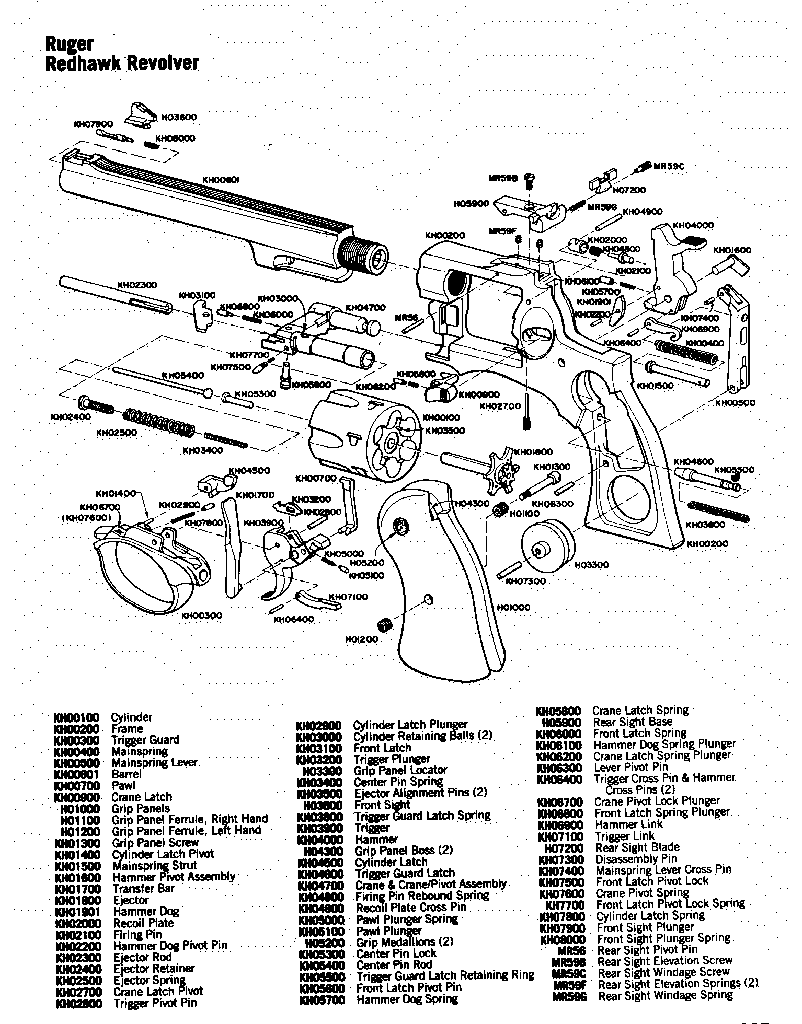 The Ruger Redhawk (introduced in 1979) is an interesting gun in that it is still in production but made somewhat obsolete by Ruger's own Super Redhawk and Ruger's new standard grip format using the stud instead of a grip frame. The Redhawk (as opposed to the Super Redhawk) is now very much old school.
The Ruger Redhawk (introduced in 1979) is an interesting gun in that it is still in production but made somewhat obsolete by Ruger's own Super Redhawk and Ruger's new standard grip format using the stud instead of a grip frame. The Redhawk (as opposed to the Super Redhawk) is now very much old school. I once owned a Security Six (.357 Magnum) and you might view the Redhawk as a development from that series, up sized and with some modifications, for larger cartridges. The Redhawk has been factory chambered for the .357 Mag, .41 Mag, .44 Mag and .45 Colt. It is hell for stout. As Ruger says on their website:
The Ruger Redhawk® revolver was Ruger's first double action revolver specifically designed for the powerful .44 Magnum cartridge. It embodies many advanced features such as a "triple-locking" cylinder, a unique "single spring" mechanism for relatively lighter trigger pull, easily replaceable front sights and adjustable rear sights, and all-stainless steel construction. Ruger Redhawks are perfect for the big game handgun hunter who needs the power of a .44 Magnum in a rugged, dependable revolver.
I really liked my Security-Six. It was a good gun, gave good service and it is unfortunate that I sold it to meet family responsibilities. For a couple of years I let the need for a home defense/hunting revolver pass me by until I had the opportunity at a S&W M629 4". I've written enough about that at the linked page. Needless to say I've been looking for another suitable revolver to fill this niche almost since I got the 629. The Redhawk seemed to be about right but... the "but"? Well the "but" was that it was pretty close to the right size but the barrels were too long. You see, they only had them in 5½ and 7½ inch lengths. Yes you can cut them down but add that expense to the MSRP and, well, that's darn expensive when you already have a "perfectly" serviceable 4" .44 Magnum in hand. So I've put it off for the longest time.

Then, about a year and a half ago, Ruger came out with the Redhawk in a 4" version. Of course I liked the idea, but it hasn't been until recently that circumstances have conspired to put one into my hands. I've now got one coming. We'll have to see if it will actually replace the M629...
My first impression of the Redhawk was that it was/is a LARGE revolver. Not as big as the X-frame S&W but big, brutal looking. Definitely and noticeably larger than the S&W 629. Fitting is not as good as I'd have liked but nothing was broken or missing. It has been factory test-fired. I do like the balance of this gun as compared to the longer 5.5 or 7.5 inch barreled guns. The verdict is still out on the grips.
While the grips are big, and I'm sure they would accommodate rather large hands, I can use them too. One thing I like is that with the issue grips I can use the gun both SA with a single hand cocking and DA one or two handed. Can't do both with any given grips on my S&W 629. Dry firing (done without the plastic disk in place) has shown that either mode is easy.
That dry firing showed something else as well. The action came to me very gritty. Now, I'm not a particularly particular person. If the trigger can be pulled, the gun shoots, if the gun stays in one piece, that is pretty good. I guess that comes from my years of military service. But I could feel and hear the grittiness in this revolver. However, as has been suggested, it has smoothed out quite a bit. One thing that hasn't changed is that the bolt rises early. As you cock the gun, SA or DA, the bolt rises to contact the cylinder about half way between the locking notches and rides the cylinder into the next notch. This has already resulted in a cylinder ring. However, it has been noted that rising early is better than rising late and the cylinder rotating past the bolt and the gun firing unlocked. But I still haven't fired the gun.
Stay tuned.
LINKS:
The Ruger Redhawk® revolver was Ruger's first double action revolver specifically designed for the powerful .44 Magnum cartridge. It embodies many advanced features such as a "triple-locking" cylinder, a unique "single spring" mechanism for relatively lighter trigger pull, easily replaceable front sights and adjustable rear sights, and all-stainless steel construction. Ruger Redhawks are perfect for the big game handgun hunter who needs the power of a .44 Magnum in a rugged, dependable revolver.
I really liked my Security-Six. It was a good gun, gave good service and it is unfortunate that I sold it to meet family responsibilities. For a couple of years I let the need for a home defense/hunting revolver pass me by until I had the opportunity at a S&W M629 4". I've written enough about that at the linked page. Needless to say I've been looking for another suitable revolver to fill this niche almost since I got the 629. The Redhawk seemed to be about right but... the "but"? Well the "but" was that it was pretty close to the right size but the barrels were too long. You see, they only had them in 5½ and 7½ inch lengths. Yes you can cut them down but add that expense to the MSRP and, well, that's darn expensive when you already have a "perfectly" serviceable 4" .44 Magnum in hand. So I've put it off for the longest time.

Then, about a year and a half ago, Ruger came out with the Redhawk in a 4" version. Of course I liked the idea, but it hasn't been until recently that circumstances have conspired to put one into my hands. I've now got one coming. We'll have to see if it will actually replace the M629...
************
My first impression of the Redhawk was that it was/is a LARGE revolver. Not as big as the X-frame S&W but big, brutal looking. Definitely and noticeably larger than the S&W 629. Fitting is not as good as I'd have liked but nothing was broken or missing. It has been factory test-fired. I do like the balance of this gun as compared to the longer 5.5 or 7.5 inch barreled guns. The verdict is still out on the grips.
While the grips are big, and I'm sure they would accommodate rather large hands, I can use them too. One thing I like is that with the issue grips I can use the gun both SA with a single hand cocking and DA one or two handed. Can't do both with any given grips on my S&W 629. Dry firing (done without the plastic disk in place) has shown that either mode is easy.
That dry firing showed something else as well. The action came to me very gritty. Now, I'm not a particularly particular person. If the trigger can be pulled, the gun shoots, if the gun stays in one piece, that is pretty good. I guess that comes from my years of military service. But I could feel and hear the grittiness in this revolver. However, as has been suggested, it has smoothed out quite a bit. One thing that hasn't changed is that the bolt rises early. As you cock the gun, SA or DA, the bolt rises to contact the cylinder about half way between the locking notches and rides the cylinder into the next notch. This has already resulted in a cylinder ring. However, it has been noted that rising early is better than rising late and the cylinder rotating past the bolt and the gun firing unlocked. But I still haven't fired the gun.
Stay tuned.
LINKS:
- Gunblast Article, "Ruger Four-Inch .44 Magnum Stainless Redhawk"
- Sturm-Ruger
- The Ruger Redhawk by Sarge
- Assembly/Disassembly of the Ruger Redhawk by Trueblue Sam
- Sturm-Ruger
- The Ruger Redhawk by Sarge
Thursday, September 18, 2008
In Memoriam - Charles "Chuck" Karwan
Charles "Chuck" Karwan died last week. Grant Cunningham posted about it on his blog which is how I know. It was good to have Mr. Karwan here, I hope we meet when it comes my turn to cross over.
Tuesday, September 16, 2008
I avoided a "bullet" in the form of a new (to me) gun...
Yeah, this is one time I didn't get the gun. Why? I'll talk about that later. What was the gun?
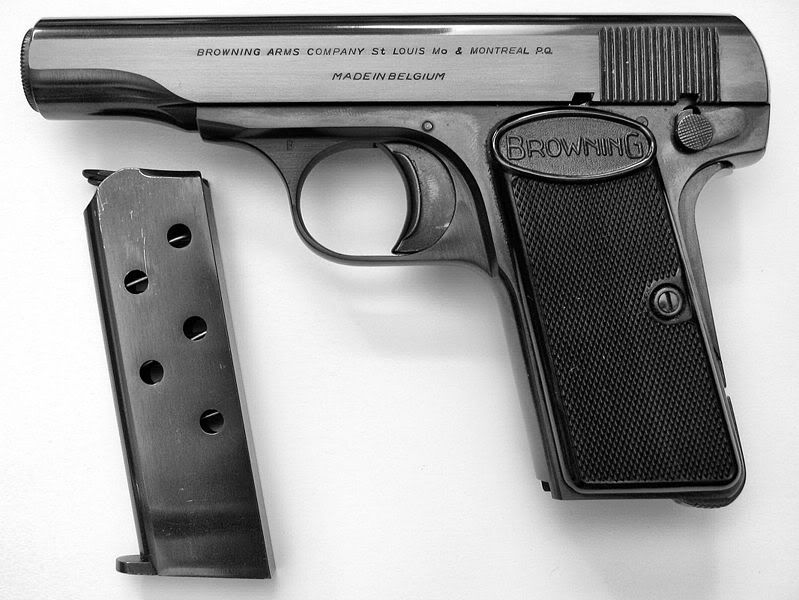 It was a Browning 1955 (or 1910) in .380 ACP (9mm Kurz) with a single magazine and the original soft case. With a serial number in the 590XXX range it appears to have been produced in 1966 (according to Proofhouse). The gun is in 98-99% condition with only a very small scratch on the rear of the slide. The trade or credit card price is $499. If interested you can call/contact Chris Kinchloe at Nuckols Gunworks, 1801 West Beverley Sreet, Staunton, VA 24401, (540) 886-3061, nuckolsgun@comcast.net.
It was a Browning 1955 (or 1910) in .380 ACP (9mm Kurz) with a single magazine and the original soft case. With a serial number in the 590XXX range it appears to have been produced in 1966 (according to Proofhouse). The gun is in 98-99% condition with only a very small scratch on the rear of the slide. The trade or credit card price is $499. If interested you can call/contact Chris Kinchloe at Nuckols Gunworks, 1801 West Beverley Sreet, Staunton, VA 24401, (540) 886-3061, nuckolsgun@comcast.net.
 Of course, I had to learn something all I could about these guns before I actually bought one. The history is pretty interesting. For example, the model was used in the assassination of Archduke Ferdinand, thus sparking World War I (serials 19074, 19075, 19120 and 19126 were acquired for the group although which was actually fired at the Archduke is unknown). The Finns used them as a limited standard military issue during the Continuation War. They were popular police arms in Europe. So, there was lots of history to interest me.
Of course, I had to learn something all I could about these guns before I actually bought one. The history is pretty interesting. For example, the model was used in the assassination of Archduke Ferdinand, thus sparking World War I (serials 19074, 19075, 19120 and 19126 were acquired for the group although which was actually fired at the Archduke is unknown). The Finns used them as a limited standard military issue during the Continuation War. They were popular police arms in Europe. So, there was lots of history to interest me.
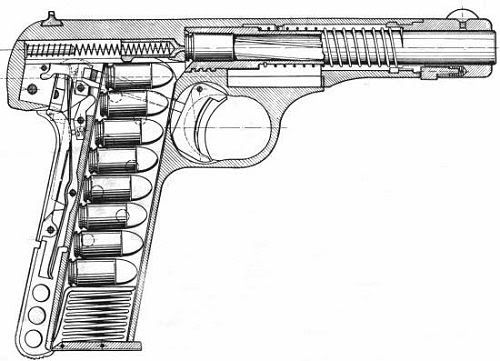 The FN (Browning) Model 1910 was a further business evolution for John Browning. His designs were previously produced by both FN in Europe and Colt in the United States. But, Colt did not want to produce the 1910 so Browning chose to patent and produce this design only in Europe. This pistol used a novel operating spring location surrounding the barrel which became the standard in the Walther PP and Russian Pistolet Makarov. It incorporated the Browning striker-firing mechanism and a grip safety along with a magazine safety and an external safety lever (known as the "triple safety") in a compact package. It was offered in both .380 ACP (6-round magazine) and .32 ACP (7-round magazine) calibers and it was produced until 1983.
The FN (Browning) Model 1910 was a further business evolution for John Browning. His designs were previously produced by both FN in Europe and Colt in the United States. But, Colt did not want to produce the 1910 so Browning chose to patent and produce this design only in Europe. This pistol used a novel operating spring location surrounding the barrel which became the standard in the Walther PP and Russian Pistolet Makarov. It incorporated the Browning striker-firing mechanism and a grip safety along with a magazine safety and an external safety lever (known as the "triple safety") in a compact package. It was offered in both .380 ACP (6-round magazine) and .32 ACP (7-round magazine) calibers and it was produced until 1983.
The guns are very compact and with the exception of the plastic or wood stocks are made entirely of steel. They feel very solid in the hand but being so small, there isn't much grip. For some people, it is difficult to grip the gun well to shoot accurately and also depress the grip safety. The sights are very small and although suitable for pocket carry, they aren't the easiest to see. Of course, these guns were designed in the era of FMJ ball ammo as standard and while they most often function 100% with ball, they might not with modern hollow points. John Browning had a winner with this one as witnessed by its long production run.
No, I didn't buy it. I wanted to but felt that on balance it was not a gun on which I should spend my assets. I felt it was a bit difficult to properly grip. I'm not sure that I could shoot it well or comfortably. I had a lot of difficulty seeing the sights with my bifocals. So that was two strikes against accurate shooting. I didn't particularly want to pick up an additional cartridge for which to load or to store. While I have a large store of .380 brass I don't have any dies and would also need bullets.
This particular gun is in such fine condition that it is like a jewel. If I had more discretionary funds I'd likely have bought it. It would still be an excellent carry gun for certain people with smaller hands. It is so small that one could carry it in modern jeans pockets.
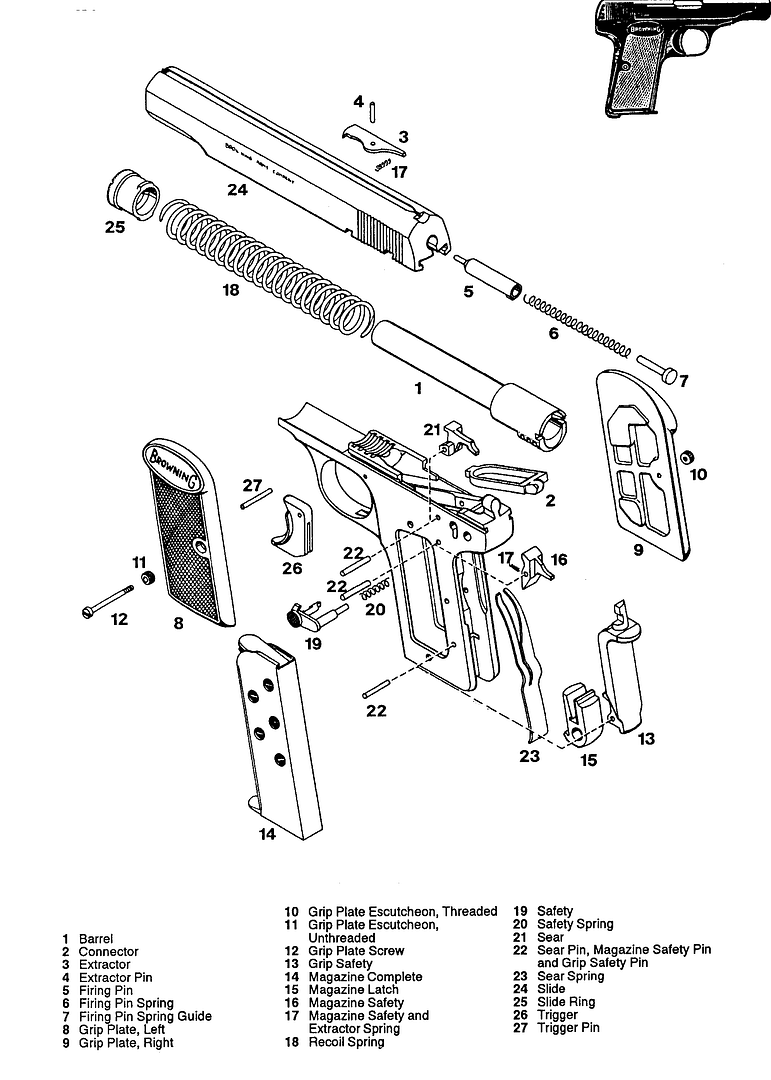
 It was a Browning 1955 (or 1910) in .380 ACP (9mm Kurz) with a single magazine and the original soft case. With a serial number in the 590XXX range it appears to have been produced in 1966 (according to Proofhouse). The gun is in 98-99% condition with only a very small scratch on the rear of the slide. The trade or credit card price is $499. If interested you can call/contact Chris Kinchloe at Nuckols Gunworks, 1801 West Beverley Sreet, Staunton, VA 24401, (540) 886-3061, nuckolsgun@comcast.net.
It was a Browning 1955 (or 1910) in .380 ACP (9mm Kurz) with a single magazine and the original soft case. With a serial number in the 590XXX range it appears to have been produced in 1966 (according to Proofhouse). The gun is in 98-99% condition with only a very small scratch on the rear of the slide. The trade or credit card price is $499. If interested you can call/contact Chris Kinchloe at Nuckols Gunworks, 1801 West Beverley Sreet, Staunton, VA 24401, (540) 886-3061, nuckolsgun@comcast.net. Of course, I had to learn something all I could about these guns before I actually bought one. The history is pretty interesting. For example, the model was used in the assassination of Archduke Ferdinand, thus sparking World War I (serials 19074, 19075, 19120 and 19126 were acquired for the group although which was actually fired at the Archduke is unknown). The Finns used them as a limited standard military issue during the Continuation War. They were popular police arms in Europe. So, there was lots of history to interest me.
Of course, I had to learn something all I could about these guns before I actually bought one. The history is pretty interesting. For example, the model was used in the assassination of Archduke Ferdinand, thus sparking World War I (serials 19074, 19075, 19120 and 19126 were acquired for the group although which was actually fired at the Archduke is unknown). The Finns used them as a limited standard military issue during the Continuation War. They were popular police arms in Europe. So, there was lots of history to interest me. The FN (Browning) Model 1910 was a further business evolution for John Browning. His designs were previously produced by both FN in Europe and Colt in the United States. But, Colt did not want to produce the 1910 so Browning chose to patent and produce this design only in Europe. This pistol used a novel operating spring location surrounding the barrel which became the standard in the Walther PP and Russian Pistolet Makarov. It incorporated the Browning striker-firing mechanism and a grip safety along with a magazine safety and an external safety lever (known as the "triple safety") in a compact package. It was offered in both .380 ACP (6-round magazine) and .32 ACP (7-round magazine) calibers and it was produced until 1983.
The FN (Browning) Model 1910 was a further business evolution for John Browning. His designs were previously produced by both FN in Europe and Colt in the United States. But, Colt did not want to produce the 1910 so Browning chose to patent and produce this design only in Europe. This pistol used a novel operating spring location surrounding the barrel which became the standard in the Walther PP and Russian Pistolet Makarov. It incorporated the Browning striker-firing mechanism and a grip safety along with a magazine safety and an external safety lever (known as the "triple safety") in a compact package. It was offered in both .380 ACP (6-round magazine) and .32 ACP (7-round magazine) calibers and it was produced until 1983. The guns are very compact and with the exception of the plastic or wood stocks are made entirely of steel. They feel very solid in the hand but being so small, there isn't much grip. For some people, it is difficult to grip the gun well to shoot accurately and also depress the grip safety. The sights are very small and although suitable for pocket carry, they aren't the easiest to see. Of course, these guns were designed in the era of FMJ ball ammo as standard and while they most often function 100% with ball, they might not with modern hollow points. John Browning had a winner with this one as witnessed by its long production run.
No, I didn't buy it. I wanted to but felt that on balance it was not a gun on which I should spend my assets. I felt it was a bit difficult to properly grip. I'm not sure that I could shoot it well or comfortably. I had a lot of difficulty seeing the sights with my bifocals. So that was two strikes against accurate shooting. I didn't particularly want to pick up an additional cartridge for which to load or to store. While I have a large store of .380 brass I don't have any dies and would also need bullets.
This particular gun is in such fine condition that it is like a jewel. If I had more discretionary funds I'd likely have bought it. It would still be an excellent carry gun for certain people with smaller hands. It is so small that one could carry it in modern jeans pockets.

.303 Cache
A poster on the Leverguns forum had a link to his album wherein was a photo of this cache of .303 Savage ammo. Gotta love it. If I had this much .303 Savage ammo I'd have a .303 Savage rifle.

Subscribe to:
Comments (Atom)






